#Thetford Heath
Text
EP Review: Eat Your Own Head - The Trawler (Drongo Records)
Norwich alt/noise-rock band Eat Your Own Head are pleased to announce the release of their upcoming new EP, The Trawler, set for release on 31st May 2024 via Drongo Records.
Eat Your Own Head count themselves as one of the bands spearheading a new wave of heavy music, redefining the UK rock scene. Known for their unpredictable twists and turns, the band veer from floor stomping riffs to tender…

View On WordPress
#&U&I#Black Midi#Blacklisters#Blakfish#Bomb Store Studio#Drongo Records#Eat Your Own Head#Lunch Money Life#Marmozets#My Octopus Mind#Nirvana#St. Pierre Snake Invasion#Sugar Horse#The Guru Guru#The Physics House Band#The Trawler#Thetford Heath
0 notes
Text
Day One: We start the Peddars Way
The Peddars Way is a wonderful ever changing, easy graded, 46 mile long distance walk starting from the pretty woodland of Knettishall Heath just outside of Thetford, through to open countryside, along quiet lanes, and Roman roads eventually leading to the North Norfolk coast at Hunstanton. This is our fifth walk here in the U.K. It dates to 61 AD, when it was used by the Romans to defeat Celtic tribes which had inhabited much of which is now Mid Norfolk. In the 15th and 16th century, this route was named Peddars Way in honor of the pilgrims and traders who walked to the religious village of Walsingham and the priory there. We picked it as it is somewhat easy for those of us who are a wee bit long-in-the-tooth.
A note here about jet lag. After a long day of travel to get from the west coast of the good ole USA, Diane and I, along with the rest of our group had no problem falling asleep. For me, the sleep of death descended almost as soon as my head hit the pillow. Regretfully, this did not last long. 3:00 am rolled around and both Diane and I were wide awake. This did give me the opportunity of working on this blog in the hours before breakfast.
Our group of eight had a delightful meal, and it was not long before a van rolled up to take us to the embarkation point of our journey. The start of the trail, Knettishal Heath, was a five mile ride outside of Thetford, and David, our driver, whisked us there in no time at all.
Today’s walk would be the shortest at 6.5 miles. Piece of cake. The well marked trail took us through a beautiful forest populated by all sorts of ferns and trees as well as thousands of lavender Digitalis or Foxglove plants. Simply gorgeous.
We did have to watch our step as sometimes the path became quite narrow with many thorny inhabitants such as stinging nettles and the dirty-evil Hogweed which had sent Diane to the hospital on our walk down the Thames River Path eight years ago. Our caution paid off as all of our group came away unscathed.
Much of the path was easy going, but things got a bit dicey as the trail narrowed and our pace slowed down considerably. On these cross country endeavors, it is hard to average more that about 2 miles an hour, and when you are basically making your way through brush and overhanging branches, 1 mph is about all you are able to achieve. But, the weather was ok and basically it is just one foot after another.
We passed a recreational area called Forest Holidays, where cabins are available to rent along with a small cafe as well as a pretty cool looking disc golf course. Just past this is where the weather turned sour. And, if that were not bad enough, the trail was flooded, halting our progress. Stopping at the cafe to assess our options, we enlisted the advice of Liv, the friendly forest ranger. What a saint. She told us to hang out, have a coffee, and she would go see how bad the flood was, and return with her recommendations. About a half hour later, she returned. We could either add 2 miles to our journey and walk around the problem venturing on the highway or take off our shoes and socks, roll up our pants and wade through the water and slime in the four areas that impeded our progress. We decided to brave the slime.
All was ok until the rain started, becoming quite heavy at times. We got soaked. And mind you, what was going to be a short walk was not even half over. Very slow going in the next hour. Very slippery making our way through the flooded areas. But, we were buoyed by the group effort, laughing our way through this setback. Fortunately, the rain abated, and it was not long before we were back in our shoes and socks, enjoying the sun which dried us out.
The forest morphed into rolling pastures populated by hog farms and fields of potatoes and vegetables.
On most of our other walks, we would simply go from inn to inn. But on this particular adventure, the towns and villages we passed through are few and far between with no facilities to house 8 travelers. So, our hosts, Let’s Go Walking UK, had arranged for us to be transported by taxi to and from inns that could accommodate our group. As we finally ended our first day’s journey, two cabs arrived to take us back to our digs in Thetford. We would be spending the night again at The Bell Hotel. Kinda funny how these things work out. After our 6.5 mile trek had morphed into over 9 miles over a period of 6 hours, the ride back to Thetford took about 15 minutes. Tired and weary but in good spirits, we had a rollicking good dinner and cocktails back at The Bell.
It was D Day, which is a big deal in this part of the world, so we went to the center of town to witness what can only be called an underwhelming commemoration. Sort of sad. We topped off our day by singing and playing ukulele on the terrace outside of our hotel.
We can only wonder what tomorrow will bring when the stakes go up a bit as we embark on a 10 mile venture to our next destination.
More to come……
1 note
·
View note
Photo

RIPU - Research, RIPU Session Week 1 (26/09/19):
I have decided that my MA projects will have East Anglia as my area of research and creative practice. I have been on holiday to East Anglia many times, and I find the region an interesting place, as the environment, historical architecture, and landmarks are distinctly different in areas.
This week, I started my RIPU project. We had our first RIPU session, which was an introductory session to talk about our MA project ideas, as well as present our personal or work-based manifestos.When presenting mine, I was still unsure about what I wanted to focus my MA on, though I knew that I wanted to create a project around East Anglia. I was suggested some research starting points, such as looking at news articles and information about East Anglia, which I have started to research (see RIPU- Research below).
My concern is that the area may be too varied to create one project about, so I could either reduce the area to a county or smaller region, or base each project on a different area. I will think more about this as I begin to plan my research starting points.
During my session this week, we have been informed that we are going on a research trip to Great Yarmouth, so this visit may help me to determine what area to pursue for my projects.
I have also been thinking about what I could discuss in my research report, as I want my research project to overlap into my creative practices in ASU1. I think that my report should focus on the environment, as this is an important topic in the world at the moment, and it is at risk in many locations, so discussing the current East Anglian environment would be an appropriate area for my report. As I want my projects to be relevant to the process and development of my Master’s Project, I will need to ensure that these benefit both myself and my research towards the final project.
I have written some ideas and notes about what I could base my report on, as well as additional notes about how I could link my report to other projects that I will complete on my MA. I used three ideas to create mindmaps from, to help me further develop my idea for my report. I have decided to relate my report to the real world, focusing on a topic that already exists, so I have chosen the themes ‘countryside’, ‘landscape’ and ‘coast’ to create my mindmaps around. I like many of the ideas I have thought of, such as ‘places of interest’, ‘inheritance’, and ‘tourist influence’. These topics are interesting to me, as I believe that I would be able to use these as a theme for my MA projects, not just my RIPU report. The topics that have interested me the most are: ‘preservation’, ‘erosion’, and ‘man-made and natural destruction of landscape’. Whilst these three topics are all relative to each other, I would like to combine these into one topic, as I think that this would be an interesting alternative way to discuss particular environmental issues. Researching areas of East Anglia will help me to decide what direction I can take this topic for my report.
RIPU - Research:
For my starting point, I have looked at various websites that are targeted as tourist spots and places of natural beauty, so that I can start to condense my idea to a key focal point.
1. I researched a website about locations on the Suffolk coast, as I wanted to see what was well-promoted in this area. Many of the activities listed are for places to stay, or activities for families, in particular, children, to participate in. This suggests to me that the environment is a key area that is promoted for tourism. On this article, I did not find promotion or tourism aimed at buildings or historical landmarks (man-made), which suggests that the Suffolk coast promotes environment/landscape-based tourism over building/man-made architecture. This could be an interesting topic for me to research in my RIPU report, as I could compare the affects of tourism on a coastal town, and the affects of tourism of a town/village inland.
2. This website focuses on attractions and places of interest on the Norfolk coast, in particular North Norfolk. The area is popular for its coastal towns, such as Cromer, and also many nature reserves and parks, such as Sheringham Park, and Thrigby Hall. I searched though the ‘attractions’ area of the ‘things to do’ page, as I felt that this would have the most variety in the activities and places to see in this area of Norfolk. This website advertises more natural attractions than man-made ones, such as parks and nature walks/reserves, which suggests that North Norfolk also promotes nature as its main area for tourism. There are also popular seaside locations, such as Great Yarmouth and Cromer that will likely be popular with tourists, which could be interesting to discover more about for my project, if this is an area that I choose to base my report on.
3. I also researched the county of Norfolk as a region to gain more information about the attractions there, as I wanted to research more about the other areas of Norfolk. This website promotes many places of heritage in Norfolk, such as the man-made Holkham Hall and Oxburgh Hall, as well as various estates, churches and gardens. There are also venue attractions such as Great Yarmouth’s Hippodrome, and Norwich theatre listed as interesting venues to visit. There are also a range of museums, mostly exhibiting the history of the town the museum is based in. Other noteworthy museums are the wind energy museum, the Dad’s Army museum and Model Soldier Museum at Houghton Hall & Gardens. There are also many wildlife-themed attractions, such as various nature reserves like Pensthorpe, and Cley Marshes; zoos, and sea-life sanctuaries. This website suggests that Norfolk’s tourism is aimed at natural or heritage-based attractions, as there are various estates that are accessible to the public, as well as wildlife sanctuaries for local and exotic wildlife to habituate in. My research also suggests there is a contrast between areas of Norfolk that are mostly countryside, and areas which are more rural. I would be interested in looking at the contrasts between the environment and rural areas, however I would need to ensure that it is linked appropriately to my report and future MA work, as I want my topic to overlap in all my MA projects. This will allow me to research extensively within my subject area, but would also allow me to explore outside it (when appropriate) as well.
4. Like Norfolk, I researched the Suffolk county as a whole to study more about the location, rather than just the coastline. Suffolk is an area with a variation of attractions, activities, and places of interest. It is home to the Latitude music festival, as well as theatres and art galleries. Famous painters, poets and musicians have created work inspired by Suffolk, where many of them lived. Museums such as Gainsbrough Hall, Moyses’ Hall and Christchurch Museum exhibit artefacts from historical figures, and also history of the surrounding landscape. Areas of heritage such as Framlingham Castle, Landguard fort and Lavenham are preserved to replicate their original architecture. Sutton Hoo is also an area of historical interest due to the Anglo-Saxon burial grounds there. There is also a wide range of estates in Suffolk, such as The Red House, Kentwell Hall and Glemham Hall, as well as landmarks such as Orfordness Lighthouse. There are also a range of seaside towns in Suffolk, such as Aldeburgh, Orfordness, Lowestoft and Southwold. Natural areas are well-promoted, such as RSPB Minsmere, as well as natural reserves and areas like Dunwich Heath, Bradfield Woods, and Thetford Forest. There is also a theme park, as well as many other family attractions and events. My research suggests that Suffolk is a hub for arts and media, as well as an area of natural beauty that is well-preserved by the many nature reserves in the county. In addition to this, Suffolk has the most range of natural and man-made landmarks and places of interest, as well as variation. This would make it an interesting area to continue researching for my project, as I would like to focus on the environment as the topic for my MA project.
5a. Cambridge is the last area of East Anglia that I researched for information about the attractions and places of interest there. Again, I researched the whole county’s attractions to have a variety of research about the types of interesting places to visit and things to do. The county has a range of museums ranging from the Fitzwilliam museum to The Polar Museum, with most of the museums focusing on the discoveries in science, architecture and computing. Interestingly, you can organise sightseeing tours of Cambridge, including some of the University’s campuses, most famously, King’s College. Other tours include city tours of Cambridge, as well as museum tours, like the Fitzwilliam museum, and heritage tours of famous buildings and architecture. In addition to walking tours, there are also punting (water/boating) tours, bus, and biking tours of the county. There are also natural areas of greenery, such as Parker’s Piece and Midsummer Common, as well as other park areas where you can see the river Cam. There are 12 nature reserve areas in Cambridge, such as Nine Wells, Barnwell West and Logan’s Meadow (5b.) In addition to this, there are also National Trust attractions around Cambridge, such as Anglesey Abbey, Wicken Fen, and the Winpole Estate (5c).
My research on Cambridge shows that for tourism, the area promotes its heritage and historic buildings predominantly. Whilst it does promote its eco-friendly image, such as through its parks and nature reserves, these are promoted less in comparison to Norfolk and Suffolk’s natural attractions. With this in mind, I do not think that I will focus on Cambridge for my MA project as, whilst it is an interesting area with many tourist-attracting areas, it focuses too much on its architecture, and I want to focus my project on the environment.
1. The Suffolk Coast (2019) Articles [Online] Available from: https://www.thesuffolkcoast.co.uk/articles [Accessed: 27/9/19]
2. Visit North Norfolk (2019) Things To See & Do In North Norfolk [Online] Available from: https://www.visitnorthnorfolk.com/see-and-do/thedms.aspx?dms=11&groupid=2&catid=28%2c13%2c67%2c47&msg=North+Norfolk+Attractions [Accessed: 27/9/19]
3. Visit Norfolk (2019) Attractions [Online] Available from: https://www.visitnorfolk.co.uk/things-to-do/Attractions.aspx [Accessed: 2/10/19]
4.Visit Suffolk (2019) Discover Great Things to Do in Suffolk [Online] Available from: https://www.visitsuffolk.com/see-and-do/ [Accessed: 2/10/19]
5a. Visit Cambridge (2019) Things To Do In Cambridge [Online] Available from: https://www.visitcambridge.org/things-to-do [Accessed: 2/10/19]
5b. Cambridge City Local Nature Reserves (2019) Nature reserved in Cambridge [Online] Available from: https://lnr.cambridge.gov.uk/visit-the-cambridge-nature-reserves/ [Accessed: 2/10/19]
5c. The National Trust (2019) Cambridgeshire [Online] Available from: https://www.nationaltrust.org.uk/days-out/regioneastofengland/in-and-around-cambridgeshire [Accessed: 2/10/19]
My research shows that East Anglia is well-promoted and advertises for both man-made and environmental/landscape tourism. I found that areas on or around the coast are scarcer in man-made landmarks, and rely heavily on their natural beauty to promote and attract tourists, whilst more rural areas of East Anglia, such as busy cities, like Cambridge, focus more on their man-made, historical beauty for tourism. My research suggests that East Anglia has a range of varied areas for both historical and natural beauty. This has made me think about my report, and how I can effectively communicate the question I choose into my 2,000-word report. I think that I need to reduce the area of my topic, as I think that there is too much I can research, which could weaken my report if I choose to write a report about the entirety of East Anglia. After looking at different counties for the research above, I think that I will condense my area of research to one or two counties, so that I can focus my research and creative practices for my MA, which will strengthen my work.
I have also included a text version of my manifesto, as I think that it will be interesting to reflect back to this when evaluating my Master’s Project. My manifesto focused on a list of ‘rules’ that I want to obey by when creating my projects, as it will be beneficial to me when creating my work, and when researching as well. I will also be able to look at this in the future and see whether my manifesto benefited my work process.
I am an animator that specialises in character animation (CGI and 2D).
Animation is a very long process but I persevere to create work that tells the world a story.
I experiment and fail but I try again from a different angle.
I create characters that express emotion to make the audience feel something.
When I need to convey subtlety, I use colour and expression to show what a character is feeling.
I visualise an idea after I have created a story for it.
If I struggle to visualise a scene, I write it out first.
This is my creative philosophy.
0 notes
Text
Grime's Graves - Wikipedia
flint mine
Grime's Graves is a large Neolithic flint mining complex in Norfolk, England. It lies 8 km (5.0 mi) north east from Brandon, Suffolk in the East of England. It was worked between c. 2600 and c. 2300 BC, although production may have continued well into the Bronze and Iron Ages (and later) owing to the low cost of flint compared with metals. Flint was much in demand for making polished stone axes in the Neolithic period. Much later, when flint had been replaced by metal tools, flint nodules were in demand for other uses, such as for building and as strikers for muskets.
The scheduled monument[1] extends over an area of some 37 ha (91 acres) and consists of at least 433 shafts dug into the natural chalk to reach seams of flint. The largest shafts are more than 14 m (46 ft) deep and 12 m (39 ft) in diameter at the surface. It has been calculated that more than 2,000 tonnes of chalk had to be removed from the larger shafts, taking 20 men around five months, before stone of sufficient quality was reached. An upper 'topstone' and middle 'wallstone' seam of flint was dug through on the way to the deeper third 'floorstone' seam which most interested the miners. The site is managed by English Heritage and can be visited.
The site is also a biological and geological Site of Special Scientific Interest[2] and a Geological Conservation Review site.[3] It is part of the Breckland Special Area of Conservation[4] and Special Protection Area.[5]
Mining method

Plan of old shaft and galleries
In order to remove the chalk efficiently, the ancient miners built wooden platforms and ladders as they dug downwards and piled the spoil around the shaft opening using turf revetments to hold it in place for the season, when the shaft and all its galleries were thoroughly and fastidiously backfilled to promote stability. The landscape around Grime's Graves has a characteristic pockmarked appearance caused by the infilled shafts. This is probably what inspired the later Anglo-Saxon inhabitants of the area to name it after their god Grim (literally the masked, or hooded one, a euphemism for Woden). Although the pagan Anglo-Saxons seem to have had some idea of what the site was, as the name of the site means literally "the masked one's quarries" (or Grim's Graben), it was not until Canon William Greenwell excavated one of the shafts in 1868–1870 that their purpose was discovered in modern times. Other similar sites have been found in Europe like Cissbury in West Sussex, Krzemionki in Poland, and Spiennes in Belgium.
The miners used picks fashioned from the antler of red deer. They probably used wooden shovels, although this is only inferred by analogy with other flint mines with better conditions for the preservation of artefacts. Analysis of the antlers (Clutton-Brock 1984: 25) has shown that the miners were mainly right-handed and favoured the left antlers out of those that were naturally shed seasonally by the deer. The 28 pits excavated up to 2008 yielded an average of 142.5 antler picks each, of which an average of 14.8 have been found to be left-handed.
Once they had reached the floorstone flint, the miners dug lateral galleries outwards from the bottom, following the flint seam. The medium-depth shafts yielded as much as 60 tons of flint nodules, which were brought to the surface and roughly worked into shape on site. The blank tools were then possibly traded elsewhere for final polishing. It is estimated that 60 tons of flint could have produced as many as 10,000 of the polished stone axes, which were the mines' main product. Extrapolation across the site suggests that Grime's Graves may have produced around 16–18,000 tonnes of flint across the 433 shafts recorded to date. However, there are large areas of the site covered by later activity which are believed to conceal many more mineshafts.
There were other hard stones used for axe manufacture, those of the Langdale axe industry and Penmaenmawr in North Wales being traded across Europe, as well as other less well-known igneous and metamorphic rocks. The axes were much in demand for forest clearance and settlement, development of farmland for arable crops and raising animals, which characterises the Neolithic period.
Customs and beliefs

Neolithic flint axe, about 31 cm (12 in) long
One unproductive shaft (pit 15) appears to have been turned into a shrine. An altar of flint lumps had been built with a chalk bowl at its base and antler picks piled around. In front of the altar had been placed a Venus figurine of chalk, a chalk phallus and some balls, also of chalk. It may have been an attempt to ensure that the mine remained productive or 'fertile' after this particular shaft turned out to have little flint in it. However, it is possible that the Venus figurine and the phallus are modern fakes – there is a lack of primary evidence surrounding their recovery in 1939, and rumours circulated at the time of the excavation that they were planted in order to deceive Leslie Armstrong, the archaeologist overseeing the dig.(Piggot 1986: 190, Longworth et al. 1991: 103–105).
Neolithic infrastructure

The remains of mineshafts, pits, and spoil heaps pockmark the surface of Grime's Graves
Such a large industry may have required supporting infrastructure. Assuming no more than two shafts were open at any one time, around 120 red deer may have needed to be bred and managed nearby, in order to provide a steady supply of antler as well as skin, food and other products that the miners would require. Alternatively, the mines may have been worked intermittently by local farmers, as happened in many early metal mines during the Bronze Age and the later Iron Age.
Earlier flint mines in Britain such as Cissbury in Sussex were just as important as Grime's Graves, and there were many very local sources of flint which were exploited on the downlands. However, it is probably relevant that Grime's Graves were close to the very rich soils of the Fens, and forest clearance here would rely on local products.
There was also extensive farming settlement during the Bronze Age, known from middens that infill the mouths of many Neolithic mineshafts. Animal bones from these middens show that the Bronze Age people kept cattle, which they milked, sheep and a few pigs. They also grew barley, wheat and peas.
The site today
Grime's Graves is in the care of English Heritage. It is open to the public and it is possible to descend a 9 m (30 ft) ladder and explore one of the shafts. There is a small exhibition area.[6] This is the only shaft of its kind open to the public in Britain.
Publications
The full English Heritage reports on the excavations at Grime's Graves in 1971–72[7][8] are now available online through the Archaeology Data Service. Doctor Philip Harding FSA, later to appear in the TV programme Time Team, dug the site each summer from 1972 to 1976.
The visitor's hut and picnic tables.
The entrance to Pit I at Grime's Graves, the only flint mine open to the public.
One of the many pits at Grime's Graves.
The first of two Second World War foxholes at Grime's Graves, located between the car park and visitor's centre.
The second of two Second World War foxholes at Grime's Graves, located on the eastern side of the site.
The exhibit in the visitor's centre.
Multimedia exhibit at the visitor's centre.
See also
References
Russell, M., (2000) Flint Mines in Neolithic Britain. Tempus. Stroud, ISBN 075241481X
Russell, M., (2002) Monuments of the British Neolithic: The Roots of Architecture. Tempus. Stroud, ISBN 0752419536
Barber, M., Field D., Topping, P, (1999)The Neolithic Flint Mines of England, Royal Commission on the Historical Monuments of England / English Heritage, ISBN 1-873592-41-8
Piggott, S., (1986) 'Early British craftsmen' Antiquity LX No 230, Pages 189-192.
Clutton-Brock, J., (1984) Excavations at Grime's Graves Norfolk 1972-1976 Fascicule 1: Neolithic Antler Picks From Grime's Graves, Norfolk, And Durrington Walls, Wiltshire: A Biometrical Analysis, British Museum Press, ISBN 0-7141-1374-3
Longworth, I., Herne, A., Varndell, G. and Needham, S., (1991) Excavations at Grimes Graves Norfolk 1972-1976 Fascicule 3: Shaft X: Bronze Age Flint, Chalk and Metalworking, British Museum Press, ISBN 0-7141-1396-4
Legge, A. J. (1991) Excavations at Grime's Graves Norfolk 1972-1976 Fascicule 4: Animals, Environment and the Bronze Age Economy. London, British Museum Press, ISBN 0-7141-1399-9
External links
Biological
Alderfen Broad
Alderford Common
Ant Broads and Marshes
Aslacton Parish Land
Badley Moor
Barnham Cross Common
Beeston Cliffs
Beetley and Hoe Meadows
Blo' Norton and Thelnetham Fens
Booton Common
Boughton Fen
Breckland Farmland
Breckland Forest
Breydon Water
Bridgham and Brettenham Heaths
The Brinks, Northwold
Broad Fen, Dilham
Bryant's Heath, Felmingham
Bure Broads and Marshes
Burgh Common and Muckfleet Marshes
Buxton Heath
Calthorpe Broad
Cantley Marshes
Castle Acre Common
Cawston and Marsham Heaths
Cockthorpe Common, Stiffkey
Coston Fen, Runhall
Cranberry Rough, Hockham
Cranwich Camp
Crostwick Marsh
Damgate Marshes, Acle
Decoy Carr, Acle
Dereham Rush Meadow
Dersingham Bog
Didlington Park Lakes
Dillington Carr
Ducan's Marsh
East Harling Common
East Ruston Common
East Walton and Adcock's Common
East Winch Common
East Wretham Heath
Eaton Chalk Pit
Edgefield Little Wood
Elm Road Field, Thetford
Felbrigg Woods
Field Barn Heaths, Hilborough
Flordon Common
Forncett Meadows
Foulden Common
Foxley Wood
Fritton Common, Morningthorpe
Gawdyhall Big Wood, Harleston
Geldeston Meadows
Great Cressingham Fen
Great Yarmouth North Denes
Grime's Graves
Gunton Park Lake
Hall Farm Fen, Hemsby
Halvergate Marshes
Hardley Flood
Hedenham Wood
Hilgay Heronry
Hockering Wood
Holly Farm Meadow, Wendling
Holt Lowes
Honeypot Wood
Hooks Well Meadows, Great Cressingham
Horningtoft Wood
Horse Wood, Mileham
Hunstanton Cliffs
Islington Heronry
Kelling Heath
Kenninghall and Banham Fens with Quidenham Mere
Leziate, Sugar and Derby Fens
Limpenhoe Meadows
Lower Wood, Ashwellthorpe
Ludham - Potter Heigham Marshes
Mattishall Moor
Middle Harling Fen
Narborough Railway Embankment
New Buckenham Common
North Norfolk Coast
Old Bodney Camp
Old Buckenham Fen
Ouse Washes
Overstrand Cliffs
Paston Great Barn
Poplar Farm Meadows, Langley
Potter and Scarning Fens, East Dereham
Potter's Carr, Cranworth
Priory Meadows, Hickling
Pulham Market Big Wood
Redgrave and Lopham Fens
Ringstead Downs
River Nar
River Wensum
Rosie Curston's Meadow, Mattishall
Roydon Common
Scoulton Mere
Sea Mere, Hingham
Sexton Wood
Shallam Dyke Marshes, Thurne
Shelfanger Meadows
Sheringham and Beeston Regis Commons
Shotesham Common
Shotesham-Woodton Hornbeam Woods
Sidestrand and Trimingham Cliffs
Smallburgh Fen
Snettisham Carstone Quarry
Southrepps Common
Stanford Training Area
Stanley and Alder Carrs, Aldeby
Stiffkey Valley
Swangey Fen, Attleborough
Swannington Upgate Common
Swanton Novers Woods
Sweetbriar Road Meadows, Norwich
Syderstone Common
Thetford Golf Course and Marsh
Thompson Water, Carr and Common
Tindall Wood, Ditchingham
Trinity Broads
Upper Thurne Broads and Marshes
Upton Broad and Marshes
Warham Camp
The Wash
Wayland Wood, Watton
Weeting Heath
Wells Chalk Pit
Westwick Lakes
Weybourne Cliffs
Whitwell Common
Winterton-Horsey Dunes
Wiveton Downs
Wretham Park Meres
Yare Broads and Marshes
Geological
0 notes
Text
Year 7 football news, Mr Barron reports, "The year 7 football team had a fairly solid start to their season last night against Thetford winning 14-0 (fourteen). They were 4-0 up after 5 minutes and when it went 5-0 we swapped our team around a little bit, but unfortunately even our goalkeeper is a very skilful outfield player! Goals were scored by Harrison Mower (3), Bailey Heath (2), Ben Handle, Sam Goldsmith, James Cox (3), Onur Kaykasuz (2). Harry Attfield, Charlie King. Team: Morton Cok Jack Collison Sam Goldsmith Harrison Mower Charlie King Onur Kaykasuz James Cox Harry Attfield Bailey Heath Ben Handle Alex Smith Alfie Neeve Say well done if you see them please! Many thanks to Mr Lyons for taking them in my absence."
from Dereham Neatherd High School https://ift.tt/1X2LDLg
via IFTTT
0 notes
Text
Diana, Vương phi xứ Wales – Wikipedia tiếng Việt là gì
Diana, Vương phi xứ Wales – Wikipedia tiếng Việt
Đối với các định nghĩa khác, xem Diana.
Diana
Vương phi xứ Wales
Vương phi xứ Wales tại The Leonardo Prize ceremony năm 1995
Thông tin chung
Phối ngẫu
Charles, Thân vương xứ Waleskết hôn 1981; ly dị 1996[1]
Hậu duệ
Hoàng tử William, Công tước xứ CambridgeHoàng tử Harry, Công tước xứ Sussex
Tên đầy đủ
Diana Frances Mountbatten-Windsor.
Tước vị
Diana, Vương phi xứ WalesHRH Vương phi xứ WalesLady Diana SpencerThe Hon Diana Spencer
Thân phụ
Edward Spencer
Thân mẫu
Frances Shand Kydd
Sinh
1 tháng 7, 1961(1961-07-01)Park House, Sandringham, Anh
Rửa tội
30 tháng 8 năm 1961Nhà thờ St. Mary Magdalene, Sandringham
Mất
31 tháng 8, 1997 (36 tuổi)Bệnh viện Pitié-Salpêtrière, Paris, Pháp
An táng
Althorp, Northamptonshire, Anh
Tôn giáo
Giáo hội Anh
Diana, Vương phi xứ Wales (Diana Frances Mountbatten-Windsor; nhũ danh Spencer; 1 tháng 7 năm 1961 – 31 tháng 8 năm 1997), báo chí Việt Nam thường gọi là Công nương thay vì Vương phi, là vợ thứ nhất của Charles, Thân vương xứ Wales[2], con trai trưởng của Nữ hoàng Elizabeth II. Hai người con trai của bà là Hoàng tử William và Hoàng tử Harry, từng xếp thứ hai và thứ ba trong thứ tự kế vị ngôi vua của Vương quốc Liên hiệp Anh và Bắc Ireland và 15 vùng đất khác thuộc Khối thịnh vượng chung trong thời gian khi bà còn sống.
Diana và Thái tử Charles công bố đính hôn vào ngày 24 tháng 2 năm 1981, và cô tham dự rất nhiều sự kiện của hoàng gia trước khi họ chính thức lấy nhau vào ngày 29 tháng 7 năm 1981 tại Nhà thờ St. Paul. Diana trở thành người nổi tiếng sau khi bà đính hôn với Thái tử Charles. Cuộc sống của bà trở thành đề tài chú ý của công chúng do địa vị hoàng gia và các hoạt động xã hội của bà. Sau nhiều năm dư luận bàn tán về các vấn đề trong cuộc sống hôn nhân của họ, khiến cho Thái tử Charles và Diana đã quyết định ly dị vào ngày 28 tháng 8 năm 1996, kết thúc cuộc hôn nhân kéo dài 15 năm của họ. Một năm sau khi Diana ly dị với Thái tử Charles, bà thiệt mạng do hậu quả của thương tích trong một vụ tai nạn xe hơi xảy ra dưới đường hầm cầu Alma ở Paris, Pháp vào ngày 31 tháng 8 năm 1997. Cái chết của bà lập tức dẫn đến một giai đoạn thương tiếc và để tang của dân chúng Anh quốc, cũng như toàn thế giới. Elton John có bài hát “Candle in the Wind 1997” để tưởng nhớ bà.
Diana Frances Spencer hay thường được gọi tắt là Diana, sinh ngày 1 tháng 7 năm 1961, tại Park House, Sandringham, Norfolk, vương quốc Anh. Bà là con thứ tư trong số năm người con của tử tước xứ Althorp, John Spencer (1924-1992), và người vợ đầu của ông Frances (1936–2004). Gia đình Spencer vốn có mối quan hệ đồng minh bền chặt với Hoàng gia Anh qua vài thế hệ. Cả hai người bà của Diana đều phục vụ như là vai trò phụ tá riêng cho nữ hoàng Anh Elizabeth, vị trí chỉ dành cho các quý tộc cao quý. Gia đình Spencer hi vọng mẹ Diana sẽ sinh một bé trai để kế thừa huyết thống dòng họ, và đã không có cái tên được chọn với tuần đầu tiên, cho đến khi họ chọn tên Diana Frances.[3][4][3]
Vào ngày 30 tháng 8 năm 1961, Diana làm lễ rửa tội tại nhà thờ St.Mary Magdalene Church, Sandringham. Có có ba người anh em ruột: Sarah, Jane, and Charles. Anh trai của cô, John, đã mất sau khi sinh một năm trước khi Diana được sinh ra. Nỗi khao khát với một người con trai thừa kế làm tăng căng thẳng đến cuộc hôn nhân của gia đình Spencers, mẹ Diana đã gửi các thông tin tới các phòng khám ở Luân Đôn để xác định nguyên nhân của vấn đề. Điều này được miêu tả là “xấu hổ” của em trai của Diana, Charles: “Đây là một khoảng thời gian khủng khiếp đối với cha mẹ tôi và có lẽ là gốc rễ của việc ly dị của họ bởi vì tôi không nghĩ họ đã vượt qua nó.Diana lớn lên ở Park House, nằm trên mảnh đất Sandringham. Gia đinh Spencers thuê ngôi nhà của nữ hoàng Elizabeth II. Hoàng gia thường xuyên đi nghỉ tại xung quoanh nhà Sandringham House, và Diana chơi với Hoàng tử Andrew và Hoàng tử khi còn nhỏ.[3][3]
Diana được 7 tuổi khi cha mẹ ly dị[5], sau khi mẹ bà có dan díu với ông Peter Shand Kydd.[6] Diana sống với mẹ ở London trong lúc cha mẹ ly thân, nhưng trong mùa lễ Giáng sinh sau Lord Althorp không cho phép Diana trở về London với mẹ. Sau đó, với sự giúp đỡ của mẹ vợ Ruth Roche, Nữ Nam tước Fermoy, John Spencer được cho quyền nuôi nấng Diana.[3] Diana ban đầu học ở Riddlesworth Hall gần Diss, Norfolk, sau đó học nội trú The New School at West Heath,[3] tại Sevenoaks, Kent. Vào năm 1973, Lord Althorp bắt đầu có quan hệ tình cảm với Raine McCorquodale, Nữ Bá tước Dartmouth, người con gái duy nhất của Alexander McCorquodale và bà Barbara Cartland.[7] Lady Dartmouth -không được Diana ưa thích- cưới Lord Spencer tại Caxton Hall, London vào ngày 14 tháng 7 năm 1976.[6] Diana trở thành Lady Diana khi cha bà thừa hưởng chức tước Earl Spencer vào ngày 9 tháng 6 năm 1975.[8]. Sau khi học xong trường tại Institut Alpin Videmanette tại Thụy Sĩ, Lady Diana dọn về London, và dạy trẻ con tại vườn trẻ Young England School.[3][3][9]
Diana ban đầu học tại nhà dưới sự giám sát của cô giáo của cô, Gertrude Allen. Cô bắt đầu tham gia hệ thống giáo dục chính thức tại trường tư Silfield trong làng Gayton, Norfolk và chuyển tới trường Riddlesworth Hall, một trường nội trú dành cho nữ giới gần Thetford, khi cô lên 9 tuổi. Cô đã tham gia cùng các chị của mình tại Trường nữ sinh West Heath ở Sevenoaks, Kent, năm 1973. Cô đã không tỏa sáng về mặt học thuật, không đạt được cấp độ O hai lần. Tinh thần cộng đồng nổi bật của cô đã được nhận ra với một giải thưởng từ West Heath. Cô rời West Heath khi cô mới mười sáu tuổi. Anh trai Charles của cô nhớ lại cô như là khá nhút nhát cho đến thời điểm đó. Cô đã thể hiện tài năng âm nhạc như là một nghệ sĩ piano thành công. Diana cũng rất xuất sắc trong việc bơi lội và lặn, và học múa ba lê và nhảy múa.
Sau khi gia nhập Viện Institut Alpin Videmanette ( trường trong Rougemont, Thụy Sĩ, dạy cho nữ sinh về các lễ nghi xã hội và văn hóa như là một sự chuẩn bị để bước vào xã hội) với một kỳ học trong năm 1978, Diana trở lại Luân Đôn, khi cô đã chia sẻ căn hộ của mẹ cô với hai bạn cùng trường. Tại Luân Đôn, cô tham gia khóa học cao cấp nấu ăn, nhưng ít khi nấu cho bạn cùng phòng. Cô tham gia một loạt công việc thu nhập thấp; cô làm như một giảng viên khiêu vũ cho thiếu niên cho đến khi khi một tai nạn trượt tuyết làm cô nghỉ đến ba tháng làm việc. Sau đó, cô tìm việc làm trợ lý trước giờ học của nhóm nhạc, làm một số công việc dọn dẹp cho chị Sarah và một vài người bạn của cô, và đã hành động như một người hầu gái tại các bữa tiệc. Diana đã dành thời gian để làm bảo mẫu cho Robertsons, một gia đình người Mỹ sinh sống ở London, và làm trợ lý giáo viên mầm non tại Trường Young England ở Pimlic. Vào tháng 7 năm 1979, mẹ cô mua cho cô một căn hộ tại Tòa án Coleherne ở Earl’s Court vào ngày sinh nhật thứ 18. Cô sống ở đó với ba bạn cùng phòng với nhau cho đến ngày 25 tháng 2 năm 1981.
Hôn nhân với Hoàng tử xứ Wales, Charles (1977–1980)[sửa | sửa mã nguồn]
Diana lần đầu gặp Charles, Hoàng tử xứ Wales, khi cô 16 tuổi, vào tháng 11 năm 1977; lúc đó Charles đang hẹn hò với chị của Diana, Sarah. Họ là khách tại một dịp cuối tuần của đất nước suốt trong mùa hè năm 1980 khi cô xem anh chơi trò polo và anh xem cô một cách nghiêm túc như một cô dâu tiềm năng. Mối quan hệ tiến triển khi Charles mời cô lên tàu du lịch hoàng gia Britannia để chuẩn bị cho chuyến đi thuyền buồm cuối tuần tới Cowes. Sau đó là một lời mời đến Balmoral (nhà ở Scotland của gia đình hoàng gia) để gặp gia đình của Charles một trong những ngày cuối tuần tháng 11 năm 1980. Diana đã được Nữ hoàng Anh và chồng nữ hoàng là Công tước xứ Edinburgh đón nhận. Hoàng tử Charles sau đó đã tán tỉnh Diana ở London. Hoàng tử đề nghị đính hôn vào ngày 6 tháng 2 năm 1981, và Lady Diana chấp nhận, nhưng sự đính hôn của họ đã được giữ bí mật trong vài tuần tới.[10]
Là một gia đình quý tộc lâu đời tại Anh, gia đình Spencer có điều kiện tốt nhất để làm sui gia với gia đình nữ hoàng. Ngoài ra người vợ sắp cưới của thái tử Wales phải có một nền giáo dục theo đạo Tin lành và phải là trinh nữ, 2 điều kiện này Diana đều có.[11] Cả hai phía, hoàng tộc cũng như gia đình Spencer, tạo cơ hội để Diana có dịp gặp gỡ thái tử Wales. Tina Brown[12] (nhà báo và là vợ của Sir Harold Evans, còn được gọi là Lady Evans) cho là hoàng tộc lúc đó đang khẩn cấp tìm người để thay thế Camilla Parker Bowles, người mà thái tử Charles vẫn còn yêu mặc dù Camilla đã có chồng.[13] Thái tử Charles và Camilla Shand, quen nhau vào mùa hè năm 1971,[14] và Charles đã tỏ tình với cô ta vào tháng 12 năm 1972, tuy nhiên không hỏi cưới.[15] Vào tháng 7 năm 1973 Camilla Shand đã thành hôn với thiếu tá Andrew Parker Bowles.[16]
Hôn ước và lễ cưới[sửa | sửa mã nguồn]
Lễ đính hôn của họ đã trở thành chính thức vào ngày 24, tháng 2, năm 1981. Diana đã lựa một một chiếc nhẫn đính hôn lớn bao gồm 14 viên kim cương đính xung quanh một viên đá sappire Ceylon hình ô van màu xanh 12- carat đặt trong vàng trắng 18 -carat, khi nó giống chiếc nhẫn đính hôn của mẹ cô. Chiếc nhân được làm bởi thợ kim hoàn của công ty Garard. Trong năm 2010, nó trở thành chiếc nhẫn đính hôn của Catherine, nữ công tước của Cambridge. Bà nội của Charles đã tặng Diana một viên ngọc bích và kim cương như một món quà đính hôn.
Sau lễ đính hôn, Diana đã rời bỏ nghề giữ trẻ và sống một thời gian ngắn tại ngôi nhà Clarence, đó là ngôi nhà của bà nội Charles. Cô sau đó sống tại điện Buckingham cho đến khi cưới. Diana là người phụ nữ Anh đầu tiên trong 300 năm trở thành vợ của một người thừa kế rõ ràng và cô cũng là cô dâu hoàng gia có một công việc được trả lương trước khi kết hôn. Cô đã xuất hiện trước công chúng lần đầu tiên với Hoàng tử Charles trong một bữa tiệc từ thiện vào tháng 3 năm 1981 tại Hội trường Goldsmiths, nơi cô gặp công chúa Monaco.
Năm hai muơi tuổi Diana trở thành Công chúa xứ Wales khi cô kết hơn với Hoàng tử xứ Wales vào ngày 29 tháng 7 năm 1981 tại nhà thờ St Paul, nơi mà phục vụ nhiều chỗ ngồi hơn tu viện Wesminster, một nhà thờ thường được sử dụng cho các lễ cưới hoàng gia. Dịch vụ này được mô tả rộng rãi như một “đám cưới trong chuyện cổ tích” và được khán giả truyền hình toàn cầu 750 triệu người xem trong khi 600.000 khán giả xếp hàng trên đường phố để bắt gặp một cặp vợ chồng trên đường đến buổi lễ. Tại thánh đường, Diana vô tình đảo ngược thứ tự của hai cái tên đầu tiên của Charles, thay vào đó nói “Philip Charles” Arthur George. Cô không nói rằng cô sẽ “vâng lời” anh ta; lời thề truyền thống đó đã bị bỏ lại theo yêu cầu của cặp đôi, điều này gây ra một số nhận xét vào thời điểm đó. Diana mặc một chiếc váy trị giá 9.000 bảng với một đuôi váy dài 7,6 mét.
Sau khi trở thành Công chúa xứ Wales, Diana được xếp hạng là người phụ nữ có vị trí cao thứ ba trong Vương quốc Anh Quốc (sau Nữ hoàng và Mẹ Nữ hoàng), và thứ năm hoặc thứ sáu theo thứ tự ưu tiên của các cõi khác, sau Nữ hoàng, vị đại diện có liên quan, Công tước xứ Edinburgh, Hoàng hậu xứ Wales và Hoàng tử xứ Wales. Trong vòng một vài năm của đám cưới, Nữ hoàng dành cho Diana có thể thấy được dấu hiệu của các thành viên trong gia đình hoàng gia; cô cho công chúa Knot Tiara của Cambridge Lover và trao cho cô huy hiệu Hoàng gia của Hoàng gia Elizabeth II.
1 tháng 7 năm 1961 – 9 tháng 6 năm 1975: The Honourable Diana Frances Spencer
9 tháng 6 năm 1975 – 29 tháng 7 năm 1981: Lady Diana Frances Spencer
29 tháng 7 năm 1981 – 28 tháng 8 năm 1996: Her Royal Highness Vương phi xứ Wales
tại Scotland: Her Royal Highness Nữ Công tước xứ Rothesay
28 tháng 8 năm 1996 – 31 tháng 8 năm 1997: Diana, Vương phi xứ Wales
^ “The Life of Diana, Princess of Wales 1961–1997”.
^ “Diana, Princess of Wales – Marriage and family”. royal.gov.uk. Truy cập ngày 23 tháng 5 năm 2012.
^ a ă â b c d đ e “Princess Diana Biography”. The Biography Channel. Truy cập ngày 30 tháng 11 năm 2016.
^ Morton, p. 99
^ Morton, p. 98
^ a ă “Princess Diana: The Early Years”. British Royals. Truy cập ngày 21 tháng 5 năm 2011.
^ “Raine Spencer: Friend not foe”. The Independent (London). Ngày 15 tháng 12 năm 2007. Truy cập ngày 21 tháng 5 năm 2011.
^ “Princess Diana: The Earl’s daughter, born to life of privilege”. CNN. Truy cập ngày 30 tháng 5 năm 2013.
^ “The Life of Diana, Princess of Wales 1961-1997”. BBC News.
^ Brown (2007), S. 177
^ Brown (2007), S. 147
^ “Tina Brown”.
^ Brown (2007), S. 178/179
^ Brown (2007), S. 163
^ Brown (2007), S. 166
^ Brown (2007), S. 167
Source link
0 notes
Text
Councils awarded £866m civils cash for housing projects – Full list
Up to 200,000 homes are set to get off the ground after the government allocated £866m to councils to support local housing projects today.
The Government is doling out the cash to more than 130 council-led civil engineering projects to make housing developments viable.
The funding is the first wave of cash allocations from the £5bn Housing Infrastructure Fund established to fix the broken housing market.
This is being channelled into delivering local infrastructure projects including roads, cycle paths, flood defences and land remediation work.
Chancellor of the Exchequer, Philip Hammond, said: “Today marks the first step of the multi-billion pound investment we announced at the Budget to help build the homes our country needs.
“This fund finances vital infrastructure such as roads, schools and bridges, which will kick-start housing development in some of Britain’s highest-demand areas.
“This support will help us meet our ambitious plan of building 300,000 new homes each year and ensure we have enough housing in areas which need it most.”
HIF projects from County Durham to Cornwall
£10m for highway infrastructure for Ashton Green housing site in Leicester, helping to unlock 3,300 homes
£10m for construction of a bypass in Botley, Hampshire, a critical road infrastructure project for 1,000 new homes
£3.6m for drainage works, new roads and footpaths at the Manor Cluster, south-east Sheffield for over 400 homes by 2025
£6.5m to help build a new primary school as part of the Ilfracombe Southern Extension in North Devon. This will help unlock 750 new homes.
First wave awards to councils from new Housing Investment Fund Local Authority Project HIF Funding (£) Adur Free Wharf – Western Harbour Arm (Shoreham-By-Sea) 10,000,000 Aylesbury Vale Aylesbury Link Road & Junction Improvements for Aylesbury Garden Town 9,500,000 Barnet Finchley Central Station 9,800,000 Barnsley Seasons Phase 3, Thurnscoe Housing Development 2,227,270 Basildon Basildon Town Centre – East Square Regeneration 9,799,500 Basingstoke and Deane Manydown 10,300,000 Bath and North East Somerset Bath Riverside 12,500,000 Bolton Rivington Chase 12,000,000 Boston Quadrant Q1 Boston 3,500,000 Breckland Thetford Northern Sustainable Urban Extension (TNSUE) 9,950,000 Brent Northwick Park 9,900,000 Brent Peel Development Site – South Kilburn Regeneration 9,999,442 Brighton and Hove King Alfred Development 15,222,601 Bristol Unlocking Lockleaze Development 6,686,000 Bristol Glencoyne Square Access scheme 3,000,000 Camden Abbey 10,000,000 Central Bedfordshire Dunstable Town Centre Regeneration 6,300,000 Chelmsford Chelmer Waterside 5,700,000 Cheltenham Portland Street, Cheltenham 3,000,000 Cherwell Howes Lane Tunnel for North West Bicester 6,700,000 Cheshire East North West Crewe Growth and Infrastructure Package 10,000,000 Cheshire East South Macclesfield Development Area 10,000,000 Cheshire West and Chester Rossfield Park, Ellesmere Port 3,000,000 Colchester Northern Gateway 5,500,000 Corby A43/Steel Road Roundabout 3,973,252 Cornwall Hayle Harbour North Quay Redevelopment – Phase II Access Spine Road 5,655,000 Cornwall West Carclaze Garden Village 2,300,000 County Durham Newton Aycliffe Housing Growth 6,875,000 Coventry Eastern Green Unlocking Development 12,727,700 Crawley Telford Place 2,000,000 Crawley Forge Wood 4,423,280 Croydon Whitgift Shopping Centre – transport works 10,000,000 Darlington West Park Garden Village 2,788,360 Derby Castleward Urban Village 3,150,000 Dover Dover Bus Rapid Transit System (BRT) 15,803,269 Ealing Grand Union Avenue Phase 3 1,000,000 East Cambridgeshire Soham Eastern Gateway 6,330,000 East Devon Axminster North-South Relief Road (ANSRR) 10,000,000 East Dorset West of New Road Link Road, West Parley 2,250,000 Eastbourne Bedfordwell Road 1,230,000 Eastleigh West of Horton Heath Strategic Development Proposal 9,330,656 Eastleigh Construction of a bypass for Botley 10,000,000 Exeter Greater Exeter Suitable Alternative Natural Green Space 3,700,000 Fareham Welborne Garden Village 9,977,045 Fylde M55 Heyhouses Link Road 3,810,000 Guildford Ash Road Bridge, to unlock housing near Ash and Tongham 10,000,000 Hackney Woodberry Down 9,960,000 Harrow Grange Farm 10,000,000 Hastings Combe Valley Sports Village 2,225,000 High Peak Hogshaw and Granby Road sites, Buxton 2,000,000 Ipswich Ipswich Garden Suburb (IGS) 9,868,351 Kettering Desborough North Marginal Viability Bid 3,636,476 Lambeth 8 Albert Embankment, London SE1 7SP 10,000,000 Lambeth Somerleyton Road, Brixton 10,000,000 Leeds Land East of Otley 6,318,000 Leeds Roundhay Road / Leopold Street: ChaCo & Unity Development 990,000 Leicester Ashton Green, Leicester 10,000,000 Lewes North Street Quarter, Lewes 10,000,000 Lewisham South Circular Road – Catford Town Centre 10,000,000 Lewisham Lewisham Gateway 10,000,000 Lincoln Spa Road development 2,824,579 Maldon Heybridge Flood Alleviation and Regeneration Scheme 7,344,700 Manchester Moss Side Integrated Healthcare Centre, Bowes Street, Moss Side 3,314,256 Manchester New Victoria, Corporation Street, Manchester 10,074,000 Mid Devon Cullompton and Culm Garden Village M5 Junction 28 upgrade 10,000,000 Mid Devon Tiverton Eastern Urban Extension access – phase 2 new A361 junction 8,200,000 Mid Sussex Northern Arc, Western Gateway 6,540,000 Newcastle upon Tyne Ouseburn – Ouseburn Mouth (OM) 1,250,000 Newcastle upon Tyne Outer West Infrastructure 9,656,714 Newcastle upon Tyne Science Central Residential Sector – Infrastructure/ Public Realm 5,000,000 North Devon Westacott, Barnstaple, North Devon 2,080,000 North Devon Ilfracombe Southern Extension, North Devon 6,500,000 North Dorset Gillingham Strategic Site Allocation 4,064,250 North Kesteven Sleaford West Quadrant 2,000,000 North Somerset Provision of utilities to land at Parklands Village 930,974 North Tyneside Killingworth Moor Key Strategic Site 8,900,000 Northumberland St Georges Hospital Link Road 4,491,278 Norwich Anglia Square 12,226,232 Oldham Broadway Green Phase 2 4,947,274 Oxford Blackbird Leys District Centre Regeneration Scheme 3,750,000 Oxford Northern Gateway (also referred to as Oxford North) 10,000,000 Oxford Osney Mead Innovation Quarter (OMIQ) 6,090,000 Peterborough Yaxley Loop Road 4,570,000 Plymouth North Prospect Regeneration Phase 4 2,825,550 Poole Poole Town Centre Regeneration – Phase II (Town Centre North) 6,000,000 Reading Dee Park Regeneration – phase 3 6,000,000 Reading Central Pool 1,392,636 Rother Blackfriars, Battle 3,240,000 Rushcliffe South of Clifton Housing Infrastructure 9,995,239 Rushmoor Aldershot Town Centre 8,400,000 Salford Plot E7/E8, Chapel Street, Salford 1,176,819 Sedgemoor East of Bridgwater Allocation 5,500,000 Selby Olympia Park, Selby 8,878,000 Sheffield Manor Cluster 3,552,558 Shropshire Western Shropshire Interchange Improvements 9,321,963 South Bucks Beaconsfield Relief Road 4,472,144 South Holland Spalding Western Relief Road 12,000,000 South Norfolk Land south of the A11, Cringleford 5,500,000 South Somerset Brimsmore Key Site, Thorne Lane, Yeovil, Somerset 1,950,000 Southampton Townhill Park Regeneration 3,750,000 Southend-on-Sea Better Queensway (BQ) 15,000,000 Stockport Weir Mill 5,617,000 Stockport Stockport Interchange – Residential 2,600,000 Stockport Hopes Carr – Hempshaw Brook 303,815 Stockton-on-Tees West Stockton Strategic Urban Extension – Elton Interchange Improvements 10,000,000 Stoke-on-Trent Burslem Town Centre 10,000,000 Stratford-on-Avon Long Marston Airfield Garden Village (LMAGV) – Phase 1 13,438,417 Swale Queenborough & Rushenden Regeneration 3,500,000 Swindon New Eastern Villages – Rowborough Eastern Access 5,000,000 Swindon Kingsdown Bridge 6,500,000 Tameside Godley Green Garden Village 10,000,000 Taunton Deane Staplegrove Spine Road 7,200,000 Teignbridge Dawlish Link, Bridge and Cycleway 4,200,000 Tewkesbury Tewkesbury Ashchurch Housing Zone – Access to the North 8,132,465 Thanet Manston/Haine Roundabout 2,544,384 Thurrock Claudian Way, Chadwell St Mary 538,000 Trafford Trafford Waters 4,080,000 Trafford Future Carrington – Phase 1 8,400,000 Trafford Partington Canalside 6,714,000 Vale of White Horse Wantage Eastern Link Road (WELR) 7,717,989 Wakefield Infrastructure for Growth at City Fields, Wakefield 1,577,500 Warrington Centre Park Link 3,685,904 Warwick Kenilworth Education & Growth 9,591,000 West Berkshire Sterling Cables Development, Newbury. 1,500,000 West Dorset Chickerell Urban Extension 1,500,000 West Lindsey Gainsborough Southern Urban Extension 2,123,184 Weymouth and Portland Ocean Views, Portland 2,838,000 Wiltshire Ashton Park Urban Extension 8,784,000 Wirral Northbank, Wirral Waters 6,004,160 Woking Sheerwater Regeneration 9,384,000 Wycombe Princes Risborough Expansion Area 12,000,000 Wycombe Realignment of Abbey Barn Lane and junction reconfiguration 7,500,000 Wyre Forest Churchfields Urban Village – Highway Infrastructure 2,700,000
0 notes
Text
Councils awarded £866m civils cash for housing projects – Full list
Up to 200,000 homes are set to get off the ground after the government allocated £866m to councils to support local housing projects today.
More than 130 council-led projects will receive Government funding to support civil engineering projects to make housing developments viable and get much-needed homes built quicker.
With the government committed to building 300,000 homes a year by the mid-2020s,
The release of funding is the first wave of funding allocation from the £5bn Housing Infrastructure Fund established to fix the broken housing market.
This will fund key local infrastructure projects including new roads, cycle paths, flood defences and land remediation work, all essential ahead of building the homes.
Without this financial support these projects would struggle to go ahead or take years for work to begin, delaying the homes these communities need. Together with the government’s Industrial Strategy, it will provide high-quality infrastructure to support economic growth.
Chancellor of the Exchequer, Philip Hammond, said: “Today marks the first step of the multi-billion pound investment we announced at the Budget to help build the homes our country needs.
“This fund finances vital infrastructure such as roads, schools and bridges, which will kick-start housing development in some of Britain’s highest-demand areas.
“This support will help us meet our ambitious plan of building 300,000 new homes each year and ensure we have enough housing in areas which need it most.”
HIF projects from County Durham to Cornwall
£10m for highway infrastructure to unlock further development at the Ashton Green housing site in Leicester, helping to unlock 3,300 homes
£10m for construction of a bypass in Botley, Hampshire, a critical strategic road infrastructure project that will help unlock the delivery of 1,000 new homes
£3.6m for drainage works, new roads and footpaths at the Manor Cluster, south-east Sheffield to help unlock more than 400 homes by 2025
£6.5m to help build a new primary school as part of the Ilfracombe Southern Extension in North Devon. This will help unlock 750 new homes.
First wave awards to councils from new Housing Investment Fund Local Authority Project HIF Funding (£) Adur Free Wharf – Western Harbour Arm (Shoreham-By-Sea) 10,000,000 Aylesbury Vale Aylesbury Link Road & Junction Improvements for Aylesbury Garden Town 9,500,000 Barnet Finchley Central Station 9,800,000 Barnsley Seasons Phase 3, Thurnscoe Housing Development 2,227,270 Basildon Basildon Town Centre – East Square Regeneration 9,799,500 Basingstoke and Deane Manydown 10,300,000 Bath and North East Somerset Bath Riverside 12,500,000 Bolton Rivington Chase 12,000,000 Boston Quadrant Q1 Boston 3,500,000 Breckland Thetford Northern Sustainable Urban Extension (TNSUE) 9,950,000 Brent Northwick Park 9,900,000 Brent Peel Development Site – South Kilburn Regeneration 9,999,442 Brighton and Hove King Alfred Development 15,222,601 Bristol Unlocking Lockleaze Development 6,686,000 Bristol Glencoyne Square Access scheme 3,000,000 Camden Abbey 10,000,000 Central Bedfordshire Dunstable Town Centre Regeneration 6,300,000 Chelmsford Chelmer Waterside 5,700,000 Cheltenham Portland Street, Cheltenham 3,000,000 Cherwell Howes Lane Tunnel for North West Bicester 6,700,000 Cheshire East North West Crewe Growth and Infrastructure Package 10,000,000 Cheshire East South Macclesfield Development Area 10,000,000 Cheshire West and Chester Rossfield Park, Ellesmere Port 3,000,000 Colchester Northern Gateway 5,500,000 Corby A43/Steel Road Roundabout 3,973,252 Cornwall Hayle Harbour North Quay Redevelopment – Phase II Access Spine Road 5,655,000 Cornwall West Carclaze Garden Village 2,300,000 County Durham Newton Aycliffe Housing Growth 6,875,000 Coventry Eastern Green Unlocking Development 12,727,700 Crawley Telford Place 2,000,000 Crawley Forge Wood 4,423,280 Croydon Whitgift Shopping Centre – transport works 10,000,000 Darlington West Park Garden Village 2,788,360 Derby Castleward Urban Village 3,150,000 Dover Dover Bus Rapid Transit System (BRT) 15,803,269 Ealing Grand Union Avenue Phase 3 1,000,000 East Cambridgeshire Soham Eastern Gateway 6,330,000 East Devon Axminster North-South Relief Road (ANSRR) 10,000,000 East Dorset West of New Road Link Road, West Parley 2,250,000 Eastbourne Bedfordwell Road 1,230,000 Eastleigh West of Horton Heath Strategic Development Proposal 9,330,656 Eastleigh Construction of a bypass for Botley 10,000,000 Exeter Greater Exeter Suitable Alternative Natural Green Space 3,700,000 Fareham Welborne Garden Village 9,977,045 Fylde M55 Heyhouses Link Road 3,810,000 Guildford Ash Road Bridge, to unlock housing near Ash and Tongham 10,000,000 Hackney Woodberry Down 9,960,000 Harrow Grange Farm 10,000,000 Hastings Combe Valley Sports Village 2,225,000 High Peak Hogshaw and Granby Road sites, Buxton 2,000,000 Ipswich Ipswich Garden Suburb (IGS) 9,868,351 Kettering Desborough North Marginal Viability Bid 3,636,476 Lambeth 8 Albert Embankment, London SE1 7SP 10,000,000 Lambeth Somerleyton Road, Brixton 10,000,000 Leeds Land East of Otley 6,318,000 Leeds Roundhay Road / Leopold Street: ChaCo & Unity Development 990,000 Leicester Ashton Green, Leicester 10,000,000 Lewes North Street Quarter, Lewes 10,000,000 Lewisham South Circular Road – Catford Town Centre 10,000,000 Lewisham Lewisham Gateway 10,000,000 Lincoln Spa Road development 2,824,579 Maldon Heybridge Flood Alleviation and Regeneration Scheme 7,344,700 Manchester Moss Side Integrated Healthcare Centre, Bowes Street, Moss Side 3,314,256 Manchester New Victoria, Corporation Street, Manchester 10,074,000 Mid Devon Cullompton and Culm Garden Village M5 Junction 28 upgrade 10,000,000 Mid Devon Tiverton Eastern Urban Extension access – phase 2 new A361 junction 8,200,000 Mid Sussex Northern Arc, Western Gateway 6,540,000 Newcastle upon Tyne Ouseburn – Ouseburn Mouth (OM) 1,250,000 Newcastle upon Tyne Outer West Infrastructure 9,656,714 Newcastle upon Tyne Science Central Residential Sector – Infrastructure/ Public Realm 5,000,000 North Devon Westacott, Barnstaple, North Devon 2,080,000 North Devon Ilfracombe Southern Extension, North Devon 6,500,000 North Dorset Gillingham Strategic Site Allocation 4,064,250 North Kesteven Sleaford West Quadrant 2,000,000 North Somerset Provision of utilities to land at Parklands Village 930,974 North Tyneside Killingworth Moor Key Strategic Site 8,900,000 Northumberland St Georges Hospital Link Road 4,491,278 Norwich Anglia Square 12,226,232 Oldham Broadway Green Phase 2 4,947,274 Oxford Blackbird Leys District Centre Regeneration Scheme 3,750,000 Oxford Northern Gateway (also referred to as Oxford North) 10,000,000 Oxford Osney Mead Innovation Quarter (OMIQ) 6,090,000 Peterborough Yaxley Loop Road 4,570,000 Plymouth North Prospect Regeneration Phase 4 2,825,550 Poole Poole Town Centre Regeneration – Phase II (Town Centre North) 6,000,000 Reading Dee Park Regeneration – phase 3 6,000,000 Reading Central Pool 1,392,636 Rother Blackfriars, Battle 3,240,000 Rushcliffe South of Clifton Housing Infrastructure 9,995,239 Rushmoor Aldershot Town Centre 8,400,000 Salford Plot E7/E8, Chapel Street, Salford 1,176,819 Sedgemoor East of Bridgwater Allocation 5,500,000 Selby Olympia Park, Selby 8,878,000 Sheffield Manor Cluster 3,552,558 Shropshire Western Shropshire Interchange Improvements 9,321,963 South Bucks Beaconsfield Relief Road 4,472,144 South Holland Spalding Western Relief Road 12,000,000 South Norfolk Land south of the A11, Cringleford 5,500,000 South Somerset Brimsmore Key Site, Thorne Lane, Yeovil, Somerset 1,950,000 Southampton Townhill Park Regeneration 3,750,000 Southend-on-Sea Better Queensway (BQ) 15,000,000 Stockport Weir Mill 5,617,000 Stockport Stockport Interchange – Residential 2,600,000 Stockport Hopes Carr – Hempshaw Brook 303,815 Stockton-on-Tees West Stockton Strategic Urban Extension – Elton Interchange Improvements 10,000,000 Stoke-on-Trent Burslem Town Centre 10,000,000 Stratford-on-Avon Long Marston Airfield Garden Village (LMAGV) – Phase 1 13,438,417 Swale Queenborough & Rushenden Regeneration 3,500,000 Swindon New Eastern Villages – Rowborough Eastern Access 5,000,000 Swindon Kingsdown Bridge 6,500,000 Tameside Godley Green Garden Village 10,000,000 Taunton Deane Staplegrove Spine Road 7,200,000 Teignbridge Dawlish Link, Bridge and Cycleway 4,200,000 Tewkesbury Tewkesbury Ashchurch Housing Zone – Access to the North 8,132,465 Thanet Manston/Haine Roundabout 2,544,384 Thurrock Claudian Way, Chadwell St Mary 538,000 Trafford Trafford Waters 4,080,000 Trafford Future Carrington – Phase 1 8,400,000 Trafford Partington Canalside 6,714,000 Vale of White Horse Wantage Eastern Link Road (WELR) 7,717,989 Wakefield Infrastructure for Growth at City Fields, Wakefield 1,577,500 Warrington Centre Park Link 3,685,904 Warwick Kenilworth Education & Growth 9,591,000 West Berkshire Sterling Cables Development, Newbury. 1,500,000 West Dorset Chickerell Urban Extension 1,500,000 West Lindsey Gainsborough Southern Urban Extension 2,123,184 Weymouth and Portland Ocean Views, Portland 2,838,000 Wiltshire Ashton Park Urban Extension 8,784,000 Wirral Northbank, Wirral Waters 6,004,160 Woking Sheerwater Regeneration 9,384,000 Wycombe Princes Risborough Expansion Area 12,000,000 Wycombe Realignment of Abbey Barn Lane and junction reconfiguration 7,500,000 Wyre Forest Churchfields Urban Village – Highway Infrastructure 2,700,000
from Construction Enquirer http://www.constructionenquirer.com/2018/02/01/866m-civils-funding-to-kick-start-housing-projects-list/
1 note
·
View note
Text
School shooting survivors united by a chain of grief – and hard lessons passed on
yahoo
It was five years ago that a young man invaded Sandy Hook Elementary School in Newtown, Conn., and shot and killed 20 young children and six staff members, a tragedy that indelibly scarred that small city and lives on in the collective national memory. But school shootings didn’t begin, or end, with Sandy Hook. Yahoo News looks at the aftermath of four of these tragedies and the lives they changed. In other stories, we examine how 20 years on, Jonesboro, Ark., is still traumatized by an attack carried out by two middle-school boys — and how survivors deal with the knowledge that the killers are now grown men and free from prison; at the lessons from Sandy Hook that may have helped save lives at a California school just last month; and at how the parents of a girl killed in Newtown are coping with their loss.
Holly Bailey, Dylan Stableford, Beth Greenfield and Jason Sickles contributed to this report.
_____
It happens soon after the shooting stops, often before the victims are buried and the crime tape is taken away, certainly while the parents and students and teachers are still numb, still reeling from their loss. Sometime during those raw, wrenching moments comes the first talk of healing.
“Faith, hope, love … healing,” read the banner at the memorial service in Jonesboro, Ark., for the five killed and 10 injured when an 11-year-old and a 13-year-old classmate pulled a fire alarm and picked off their victims as they marched out of their middle school in 1998.
“Healing Begins,” read the headline of the Denver Post the day after two students gunned down 14 classmates and a teacher, injuring 23 more, at Columbine High School in 1999. A month later, President Bill Clinton addressed thousands at a memorial service. “There has to be healing,” he said.
After 32 were killed and 23 were injured by a student on a rampage at Virginia Tech, President George W. Bush promised healing too. “Although it does not seem possible right now,” he said, “a day will come when Virginia Tech will return to normal.”
And hours after an intruder killed 20 first graders and staff members in Newtown, Conn., a school aide who’d witnessed the carnage told a television reporter: “We’re going to stick together and in time, we’re going to heal.”
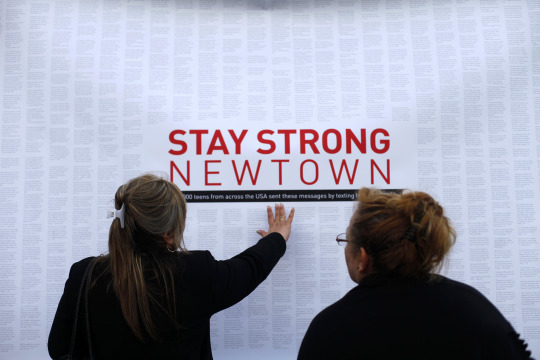
A woman touches a printout of messages of support and shared grief from teenagers around the United States at a memorial for the victims of the Sandy Hook Elementary School shooting in Newtown, Conn., Dec. 18, 2012. (Photo: Joshua Lott/Reuters)
Today is the fifth anniversary of that day, the fifth anniversary of that declaration. And the question thrumming beneath today’s memories and tributes is twofold: not just “Has Newtown healed?” but also “How does a community heal after this increasingly frequent kind of a loss?”
The roots of these questions are generations deep, back to a time well before Newtown, arguably before the American Revolution, when four Lenape tribe members entered the Enoch Brown schoolhouse in Pennsylvania in 1764, shooting and killing the schoolmaster, then murdering all but two of the children in the building.
And they are questions that stretch into the future, to a time well after Newtown, through the at least 104 times that shots have been fired at students and teachers since Dec. 14, 2012.
Finally, they are questions that ripple out beyond these communities, particularly as screens and cameras now bring the anguish to the nation as a whole, allowing strangers to mourn for, though not actually with, those who have suffered.
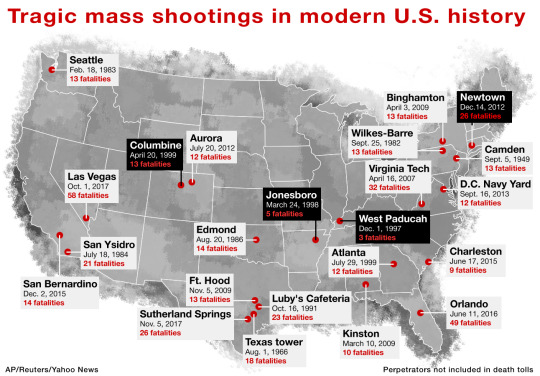
It’s not only schools where communities are ripped to shreds and left to knit the pieces back together. The lessons of the schools are also the lessons of the military bases at Fort Hood and the Washington Navy Yard, the movie theater in Aurora, Colo., the churches in Charleston, S.C., and Sutherland Springs, Texas, and the concert in Las Vegas.
But there is something singular and searing about the schools — an invasion of what is assumed to be a safe space, where the victims form a literal community, where families not only know each other, but also expect their lives to be entwined as their children grow.
And unlike many other kinds of spaces, school communities remain together, to nurse their collective wound, after the cameras have gone, after the politicians have gone to their ideological corners (“guns,” “mental health”) then departed, after the public has moved on, wearied by the seemingly constant march of death, and jaded by the gridlock and dysfunction that prevent any real change.
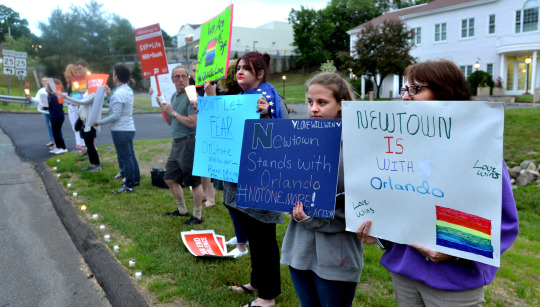
Nearly two dozen protesters showed up in front of the National Shooting Sports Foundation in Newtown, Conn., for a candlelight vigil to remember the victims of the Orlando mass shooting, which took place June 12, 2016. (Photo: Peter Casolino/Hartford Courant/TNS via Getty Images)
That’s when residents are left to figure out what healing means, and to navigate their way toward it. Their only real map is the cobbled-together wisdom of others who came before. It’s critically injured Jonesboro teacher Lynette Thetford receiving a letter from the mother of a girl who had been killed a few months earlier in a school shooting in West Paducah, Ky. It’s Columbine principal Frank DeAngelis getting a phone call from his Paducah counterpart, Bill Bond, who told him: “You don’t even know what you need right now. I was there. Take my number. When you need to talk, give me a call.” It’s Newtown helping Troutdale helping Marysville helping Roseburg helping Rancho Tehama helping Aztec. Together all these form a time-lapse of the healing process, each at a different point on a metaphorical journey, the totality of which extends across the nation and the decades.
Newtown is five years into this process. Have residents healed? If so, how? If not, when? And what lessons have they learned from others who’ve traveled the same increasingly familiar path?
_____

A Heath High School student screams at the scene of a shooting at the school, Dec. 1, 1997, which left three students dead and five wounded. (Photo: Steve Nagy/The Paducah Sun/AP)
Just before 8 a.m. on Dec. 1, 1997, 14-year-old Michael Carneal walked into Heath High School in West Paducah, Ky., with several shotguns in his backpack. With a Ruger MK II .22-caliber pistol, he fired eight rounds at a group of classmates gathered in the lobby for the regular morning prayer circle. Three were killed. Five were wounded, one of them paralyzed by a bullet to the chest. Then, with one bullet still left in the chamber, Carneal put his weapon on the ground, slumped to the floor and told the approaching principal, Bill Bond: “Kill me, please kill me. I can’t believe I did that.”
With that, Paducah became the first name on the contemporary roll call of mass shootings at schools. The first of what would turn into an onslaught. The town that will always be 15 years ahead of Newtown in the healing process.
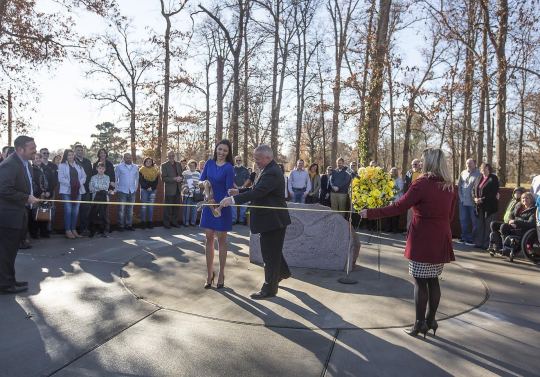
Survivors, family and community members attend a ribbon cutting ceremony Dec. 1, 2017, at the new location of a memorial for the victims of the Heath High School shooting. (Photo: Ryan Hermens/The Sun)
There had been a handful of others in the months beforehand — that February two had been killed and two wounded at Bethel Regional High School in Alaska; that October, three had been killed and seven wounded at Pearl High School
in Mississippi — but it was Paducah that raised the specter of a trend, a sign that something was new and very wrong.
“In my whole life, it had never crossed my mind” that someone would shoot up a school, Bond told the local NBC affiliate during an interview on the 20th anniversary earlier this month. “Now, there’s not a high school principal in the nation that … it doesn’t flick in his mind sometime every day.”
So much else that happened in Paducah would eventually become familiar pieces in the response to shootings. There were lawsuits. The parents of the victims sued the parents of the shooter, eventually settling for $42 million — money that, practically, they will never receive. Lawsuits against the manufacturers of violent and pornographic video games, movies and websites were less successful, and were eventually dismissed.

There were broken families. After 15-year-old Kayce Steger died, her parents dealt with their grief in different ways, leading them to divorce.
There was PTSD. Kayce’s mother, a nurse, could not walk into the ER of the hospital in which she works. And eventually there was the rift between those in the community who felt it was time to move on and those who felt they were being told to forget. Former students became outraged recently when they realized the memorial to their murdered classmates had been locked behind a gate rather than in a place any student could visit and reflect. Access has been restored.
There were some who forgave — most notably Missy Jenkins, who was paralyzed from the waist down that day, and who got married, had two children and is now a day treatment counselor at a nearby school. She visited her assailant in prison (he was sentenced to 25 years to life) and, she said, “I did not forgive him to make him feel better. I forgave him to make me feel better, to help me move on.”
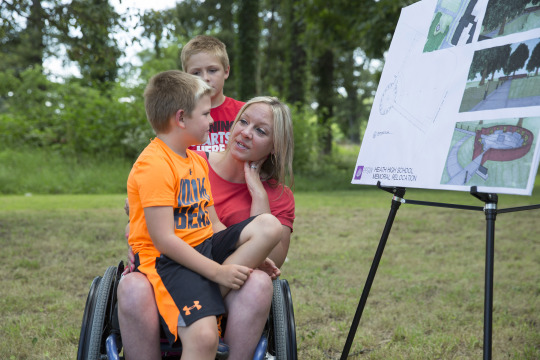
Missy Jenkins Smith, who was shot during the Heath High School shooting in 1997 and paralyzed from the chest down, talks to her sons, Carter Smith, 7, and Logan Smith, 9, about the shooting. (Photo: Ryan Hermens/The Paducah Sun via AP)
There are others who can’t quite forgive themselves. Bond still wonders which lives he might have saved “if it had only taken eight” rather than “12 seconds” for him “to get that gun.” He stayed at Heath until the last of the survivors graduated, then crafted a career as a consultant on middle school safety. He just retired from that role, and says his last interview on the subject was the one he gave to the local news on the 20th anniversary.
He has visited 15 schools in the immediate aftermath of a shooting incident, he said, jumping on a plane sometimes within hours of the news because “I needed to go help those people. I know how bad I needed help and there wasn’t anybody who had been through it. There wasn’t anybody coming.”
_____
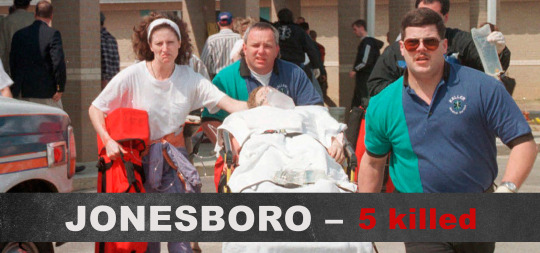
Emergency personnel rush an unidentified injured student to an ambulance at Westside Middle School near Jonesboro, Ark., March 24, 1998. (Photo: Curt Hodges/Jonesboro Sun/AP)
The chain of grief that originated in Paducah next appeared less than 200 miles away in Jonesboro, Ark. Karen Curtner, the 35-year-old founding principal of the two-year-old Westside Middle School, knew about the shootings the year before, but still, she first thought that the wailing alarm she was responding to on the morning of March 24, 1998, was either a malfunction or a prank.
Some of her teachers already suspected it wasn’t actually a fire; someone had seen a sixth grader, Andrew Golden, pull that alarm and dash outside. But “when the fire alarm goes off, you know what the rule is,” she recalled recently in an interview with Yahoo News. “Everybody leaves.”
Everybody did. Students and teachers were gathering on the lawn when Curtner stepped out of the building and heard the next sound. “My parents, everybody I’ve ever been around, have always been hunters,” she says. “So I knew what it was.”

Karen Curtner was the principal at Westside Middle School at the time of the Jonesboro shooting. (Photo: Eric Thayer/Yahoo News)
What she means is that she knew it was the sound of rifle fire. What she didn’t yet realize, because it was so unthinkable, was that 11-year-old Golden had pulled the alarm in order to lure the entire school outside and that he and his 13-year-old schoolmate Mitchell Johnson were now standing in the woods and shooting guns they’d stolen from Golden’s grandfather.
Four students and a teacher were killed that day, and 10 others were wounded, many severely. While there was press coverage of Paducah, it was nothing like what happened in Jonesboro — the first time the satellite trucks descended in such numbers that there appeared to be more journalists than residents. At least one who said he was a journalist turned out to be a stalker — police found piles of newspapers in his car with Curtner’s photo circled in most of them.
With the press came national attention, some of it welcome (victims of the Oklahoma City bombing sent piles of teddy bears to comfort the students), much of it not. (There were threats against both staff and teachers from many, including one letter purportedly from the Unabomber, praising the shooters.) There were almost too many letters to read, but when the one from the mother of one of the girls killed in Paducah made its way to Thetford, “I remember just holding onto it and crying,” she says. Hearing “from someone that I felt actually understood what we were going through meant more than words could ever say.”
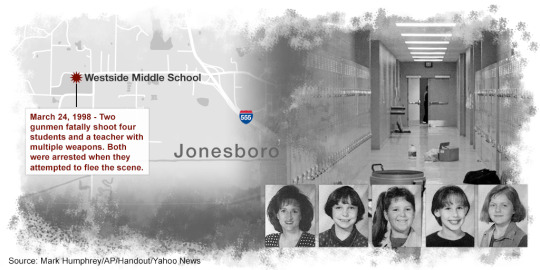
Garth Brooks contacted Curtner about performing a benefit concert, and Tiger Woods wanted to hold a golf tournament to raise money for the victims. Curtner said no to both because her focus was on getting her school “back to normal.” Like Paducah, “normal” for this community would prove to be a hazy and moving target. Marriages ended. Families moved. Lawsuits were filed.
Depression and survivors’ guilt settled like a fog. Brandi Varner later told a reporter that she’d spent much of her little sister’s funeral wishing she’d tried harder to get Britthney to skip school the day of the shooting, since they’d both stayed up so late watching the Oscars on TV the night before. Thetford, a social studies teacher nearly killed by a bullet to her abdomen, spent much of her time thinking about her friend Shannon Wright, the one teacher who was killed. Wright was younger than Thetford; her child was younger than Thetford’s. Why did Wright die but Thetford live? Then one day Thetford found herself saying to her mother, “I don’t understand why Shannon got to die and I had to stay here.” That’s when she sought counseling.
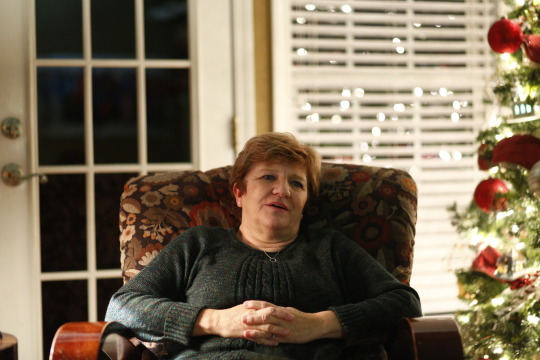
Lynette Thetford was wounded in the shooting at Westside Middle School. (Photo: Eric Thayer for Yahoo News)
Life changes were made. Some of those were a response to triggers — Thetford, for one, found herself crying while searching for a video to accompany a lesson on trench warfare during WW I. She decided in that moment that she had to stop teaching social studies, because so much of the curriculum was about violence.
Some were a response to grief — Britthney’s mother and stepfather divorced, because, her mother would say later, she withdrew her love from her husband for fear of ever losing someone she loved again. Older sister Brandi, in turn, went “buck-ass crazy,” as she described it to reporter David Peisner 15 years after the shooting, by which she meant she started drinking, smoking pot and having sex. She was expelled from high school, but turned into a “super-protective” parent of her two children. When her youngest child, a daughter who looked a lot like Britthney, started school, Brandi insisted she attend the smallest possible magnet school to make it easier for her to keep track of how all the other parents stored their guns.
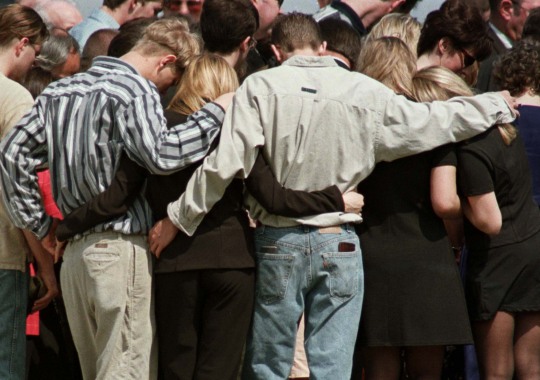
Students of Westside School bow their heads in prayer at the burial service for teacher Shannon Wright, March 28, 1998. Wright was killed while using her body to shield students from gunfire. (Photo: John Kuntz/Reuters)
And some of the changes were a response to fear. Like Paducah, Jonesboro is unusual in that the shooters lived. Unlike Paducah, or any other place where there was a school shooting, these shooters were released on their 21st birthdays — Johnson in 2005, Golden in 2007. Johnson was soon re-imprisoned for carrying an unregistered gun, but has since been released and is living in Texas; Golden now lives in Missouri and has been married at least once. He changed his name to Drew Grant, and used that name to apply for a permit to carry a concealed weapon; he was denied after a standard fingerprint search.
This leaves many in Jonesboro afraid one or both will come back to finish the job. One teacher told BuzzFeed News that she’d gone so far as to move to a new house with a different phone number and change her appearance, including losing 100 pounds, so that she would be unrecognizable to her former student.
With so many feeling this much, it was almost inevitable that they would collide over time with those who felt it was time to move on. Thetford, for instance, gave interviews after many other victims had stopped, because, she said, she wanted to share the renewed faith in God that she had found in her near-death experience. Then one day she opened a letter accusing her of grandstanding and “enjoying the notoriety.” It warned her to “SHUT UP.”
_____
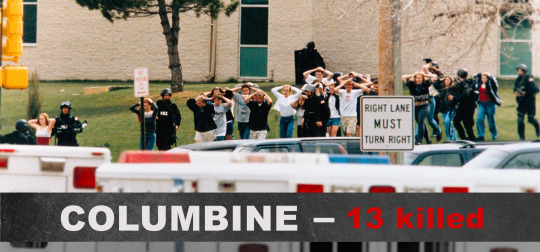
Students exit Columbine High School after two gunmen went on a shooting spree, killing 15 including themselves, on April 20, 1999, in Littleton, Colo. (Photo: Steve Starr/Corbis/Corbis via Getty Images)
Karen Curtner first heard when a reporter called, asking for comment. “Oh, God, not again,” she said, turning on the television in her Westside Middle School office on April 20, 1999, to watch what was unfolding at Columbine High School, three states and 1,000 miles away.
Lynette Thetford, in turn, who had not yet stopped teaching social studies, was in her classroom that day, with its view of the playground where she’d been shot just over a year earlier. As other teachers came to warn her, they formed a circle, held hands, and began to pray.
There had been seven school shootings and 15 fatalities since the one in Jonesboro. Now this one, in Littleton, Colo., was being carried live on national TV. Two students went on a rampage through the building, killing 12 classmates, one teacher and then themselves.

Investigators tag evidence at Columbine High School. (Photo: Dennis Schroeder/Polaris)
The aftermath — the lawsuits, the failed marriages, the fights over donated money, the desire by some to just get over it already — was familiar. But Columbine caught hold of the nation’s attention like none that had come before, both because of the number of victims (at the time it was the largest school shooting in the United States) and the new 24/7 news cycle. (The Columbine graduation a month later was also carried live, by CNN.) Columbine was also the tipping point. Following Paducah, Jonesboro and others, the idea of a teenager shooting his classmates looked like a grim trend, an evil infecting America’s children. “The Monsters Next Door” read the cover of Time magazine. Newsweek asked, “Why Did They Do It?”
Gradually the spotlight dimmed, leaving the community to piece itself back together in the new shadow. Much of that fell to Frank DeAngelis, the principal of Columbine, who was still suffering the personal aftershocks of facing down the student killers. As he walked out of his office moments after the shooting began, Eric Harris and Dylan Klebold were marching toward him, long guns blazing. One bullet hit a glass wall directly behind DeAngelis’s head, he said in an interview with Yahoo News. Seeing the girls’ volleyball team heading up the hallway toward the shooters, DeAngelis diverted them into a nearby closet, probably saving their lives.
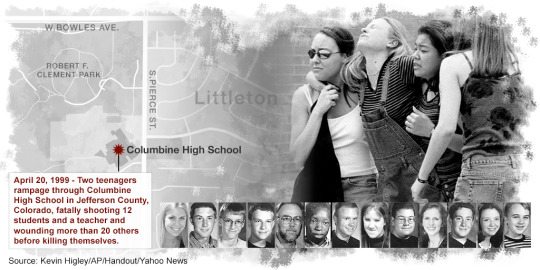
The lives he didn’t save haunted him, however, and through the summer, while planning for the reopening of the school (students finished the academic year in space shared with another district high school), he was also trying not to fall apart. He kept seeing the shooters coming toward him, the killers they were juxtaposed with the boys he thought he knew — middle schoolers in their soccer uniforms, missing teeth; seemingly happy seniors, high-fiving him at the prom two weeks earlier.
He spent nights alone in his basement “with a stiff drink and my golden retriever,” unable to unsee the school’s library, where most of the victims died, with FBI markers and blood still on the floor. When he managed to sleep, it was fitful, and he often woke by 3 a.m. and went to sit in the local church until dawn.
Thrice-weekly counseling and a feeling of responsibility got him through that summer. “There wasn’t a template for rebuilding a school and holding a community together,” Bond said. “Frank built that template.”
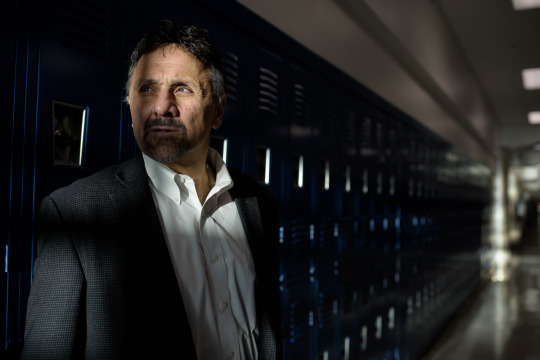
Frank DeAngelis, the principal of Columbine when the shootings occurred, photographed at the school in Dec. 2017. (Photo: Carl Bower for Yahoo News)
Bond called DeAngelis to offer his support. Thetford went to Littleton during Jonesboro’s summer break to tell residents, “It won’t ever be OK, but it will get better.”
Frank Ochberg made regular visits too. A clinical professor of psychiatry at Michigan State University and a member of the team that first formulated the PTSD diagnosis, Ochberg was developing a sad subspecialty in healing after mass shootings. The students would likely do better than the adults, he counseled, because more resources and care would inevitably be focused on them and because they are more resilient.
With advice from all corners, Columbine High School reopened in August 1999. A phalanx of parents formed a line by the entrance, welcoming the students back with a show of emotional support, and physically shielding them from the press. The library was closed, though not yet torn down and rebuilt. The walls were repainted in shades that psychologists had advised were soothing. A new aquarium was there for the same reason.
Copious attention had been paid to the fire alarms. Those alarms had wailed for the entire five hours it took police officers to rescue students from their hiding places in April, and one thing learned in Jonesboro was that the sound of any alarm, but particularly that same alarm, would trigger emotional tsunamis in those who had been there that day.
DeAngelis had spent hours in meetings with alarm companies “coming up with sounds that were different to what we had used prior.” All around the country, schools had started responding to the wave of shootings by initiating lockdown drills, but those were a fraught subject at Columbine.

The New Hope Memorial Columbine Library at Columbine High School in 2004. The original library, where a majority of students were killed, was torn down. (Photo: Ed Andrieski/AP)
“We couldn’t just say we don’t have to do drills,” DeAngelis recalled. “So we did them in baby steps.” First there was a version where teachers quietly told students to stand where they would if they were evacuating for a fire. The next step was to add the sound of the alarm only after everyone had taken their places outside the building. Eventually DeAngelis would give advance warning that there would be a fire drill the next day — some parents chose to keep their children home — and would count down on the PA system to the moment the alarm went off so it wouldn’t take anyone by surprise.
For months, then years, DeAngelis found himself trying to balance the needs of those who wanted to move on with those who could not.
“There were those who felt the sooner I stop talking about it, the sooner they could heal,” he said. “A lot of people felt that if we could just get back to doing what we were doing we will be OK. I respectfully disagreed. To think you are going to forget about what happened that day just because you go back to resuming your daily activities? It’s not going to happen.”
He pledged to stay in the job until 2002, when the last class who’d been present that day had graduated. (Eventually he expanded that pledge to any student who had been in a preschool feeder school, and didn’t retire until 2014.) As happened at Paducah, Jonesboro and others, though, his staff began to leave.

Former Columbine principal DeAngelis chats with students at the school in April 2014. (Photo: RJ Sangosti/The Denver Post via Getty Images)
“Bill Bonds warned me early on that ‘within four years 75 percent of your staff members will be gone,’” he recalled. “I said, ‘Bill, that’s not going to happen.’ What I didn’t anticipate is the impact of walking into the building each day. People who during summer break seemed to be doing well … walked back in and their blood pressure went up.” Attrition increased dramatically, and by the time DeAngelis retired, only 10 percent of the original staff was left.
Also as predicted, he said, the students did prove to be resilient. The Columbine classes of 1999 through 2002 — the students who were in the building on the day of the shooting — are still unusually close-knit, several members say.
“We get together for barbeques, we play fantasy football, most of us have kids,” Patrick Ireland, who still carries shrapnel in his brain and who had to relearn how to do practically everything, told Yahoo News. The owner of a wealth management business near Denver, his children are now 7 and 3, and “things are great,” he said. He still gets a flood of supportive texts and phone calls every April 20, “saying, ‘I’m thinking of you,’” he said. But during most ordinary days, he believes “this was one event, this was something that happened — something that we want to acknowledge and understand, but it’s not going to be the thing that defines me as a person.”

Columbine shooting victim Patrick Ireland in December 2017. (Photo: Carl Bower for Yahoo News)
DeAngelis says the class he still worries about most is the Columbine Class of 1999 — students who graduated on May 22, a month and two days after the shooting, then dispersed to college and work. “There wasn’t support for them,” he said. “The kids and staff who returned, it was tough, but we had each other. The ones who left, they would be sitting in class and the fire alarm went off and they found themselves having a meltdown and they weren’t sure why. Or they’d be doing well and five years down the line they would lose it and the help is not there.”
In the same way, he said, he worries about mass attack victims who do not have a community — those who randomly happened to be watching “Batman” in Aurora, or a concert in Las Vegas, or even working in various offices in the World Trade Center.
Visiting Virginia Tech for the first anniversary of the shooting there, he told faculty and students, “The difference for you compared with Columbine or Paducah or Jonesboro is you had kids coming from everywhere — different states, different countries — then going back there. For Columbine, the people lived in our community; we had a sense of community. At first that creates a bigger wound, but I also think it helps with the healing.”
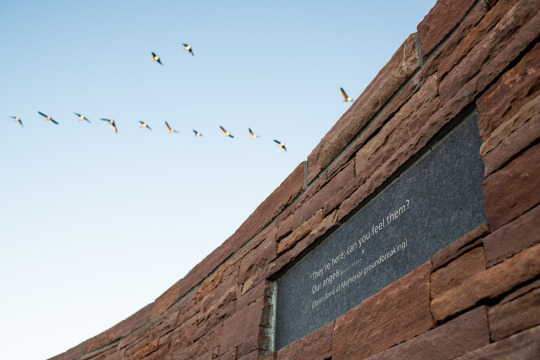
The Columbine Memorial in Littleton, Colo. (Photo: Carl Bower for Yahoo News)
Watching the students heal helped DeAngelis too. Over time, he said, “I got to the point where when I was coming out of my office, I wasn’t seeing the gunmen coming. Instead I saw Lauren Townsend playing volleyball, I saw Isaiah Shoals high-fiving me, I saw Rachel Scott on the stage performing, I envisioned Danny Mauser and Kelly Fleming down at church. I saw these kids not dying in our school, but living in our school.”
As he started to heal, he also started making phone calls. “You’re not going to remember anything we talk about today,” he would say when he got a shaken community leader on the line, “but please take down my number and call me if you ever need anything.”
_____

Two Connecticut State Police officers accompany a class of students and two adults out of Sandy Hook Elementary School on Dec. 14, 2012, in Newtown, Conn. (Photo: Shannon Hicks/Newtown Bee/Polaris)
As news poured forth from Newtown, Conn., on Dec. 14, 2012 — 151 shots fired in five minutes; 26 dead, including 20 first graders and six of their teachers at the Sandy Hook Elementary School — Coni Sanders received a call from her mother, Linda.
William “Dave” Sanders, who was Coni’s father and Linda’s husband, was the one teacher killed at Columbine, and in the 13 years since, Linda had not moved past her grief. Still living in the home near the high school, keeping the house “like a shrine” to the day her husband left it for the last time, Linda was now sobbing and shrieking in pain.
“’It’s Christmas, it’s Christmas,’” Coni, who became a forensic psychologist working with violent offenders, remembers her mother saying. “’Those babies, those babies, those babies.’”
Said Coni: “I seriously thought I was going to lose my mom.”
A few blocks away, hours to days later, Frank DeAngelis was also “having a meltdown” during a phone call. He’d been offering a shoulder to someone in Newtown when he began shaking and sweating. He grasped the medals he’s worn around his neck since 1999 — a crucifix, the Blessed Virgin — and rubbed them rhythmically to calm down. Then he continued pacing, stroking, talking.

Coni Sanders looks at a photo of her father, William “Dave” Sanders, who was killed in the Columbine shooting. (Photo: Carl Bower for Yahoo News)
There had been 92 school shootings between Columbine and Newtown, and with each, particularly the larger and more publicized ones, those who came before watched as those who came after became part of the “club that no one wants to join,” as DeAngelis calls it.
Jonesboro sent teddy bears to the children of Newtown — more than 6,000 of them filling two 18-wheelers — just as Oklahoma City victims had done for Westside students, some of whom still had theirs 13 years later.
A three-car caravan of former students drove to Connecticut from Red Lake, Minn., because when a 16-year-old student killed 10 and injured seven at Red Lake High School in 2005, several Columbine survivors had driven out to see them.
Those with personal experiences of school violence joined with those who had not, and soon the entire country seemed to be sending stuff to Newtown. Eventually the town assessor would recruit 580 volunteers over the months to work in a donated warehouse sorting and cataloging it all: a total of 63,780 teddy bears, 636 boxes of toys, more than 2,200 boxes of school supplies and a stunning number of boxes of tissues.
President Barack Obama came, later calling Newtown the toughest day of his presidency, and telling a packed and tearful interfaith vigil, “I am very mindful that mere words cannot match the depths of your sorrow, nor can they heal your wounded hearts.”
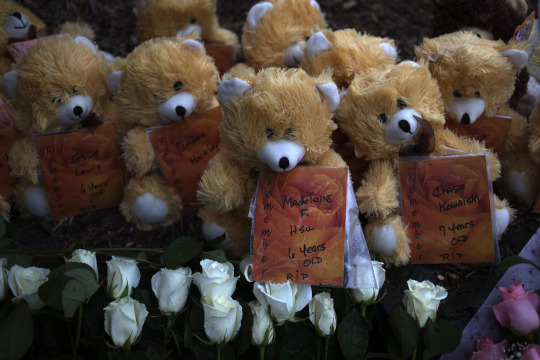
The names of victims from the Sandy Hook shooting are attached to teddy bears, part of a memorial in Sandy Hook Village two days after the shooting. (Photo: Adrees Latif/Reuters)
Vice President Joe Biden came after that, meeting privately with grieving parents, recalling the loss of his own wife and young daughter in a car crash decades earlier. Nicole Hockley, whose son Dylan was among those killed, remembers Biden’s advice to keep a daily journal, ranking each day from one to 10, “where one is the worst and a 10 is the best.”
His message, Hockley said, was “You may never have a 10 again, but over time you’re going to see that you’re getting into the fives and the sixes and sevens, and then you’re going to go backwards again and be at the low numbers, and then you’re going to move forward again. And then that’s something useful to look back over time to say, ‘I made it through.’ ”

To the earlier waves of survivors watching from afar, everything about Newtown was familiar, but also bigger. Where Paducah turned away celebrities’ offers to help, Newtown was flooded with them: Giants receiver Victor Cruz visited the family of one little boy who had been buried in the player’s jersey; Harry Connick Jr. visited the family of another victim, whose father had played in Connick’s band. James Taylor gave a concert for family members of the dead at the local church and sang “Sweet Baby James” — to a family whose son had carried that name.
Where a few parents of earlier shootings had become crusaders — Suzann Wilson lobbied for the Brady Campaign to Prevent Gun Violence after Britthney died in Jonesboro, and Tom Mauser, literally wearing the shoes of his murdered son Daniel, lobbied for local and national gun control after Columbine — Newtown raised the participation and the stakes. Obama sent Air Force One to bring families to Washington, where they walked the halls of Congress with photographs of their dead 6- and 7-year olds, lobbying for expanded background checks on firearms.
And when the measure failed, disillusionment came with a new forcefulness too. “Why wasn’t Sandy Hook the mass shooting that changed everything?” Vice News asked in a headline. Then reporter Matt Taylor answered that question: “Mass shootings are increasingly accepted — by about three quarters of us — as an essential part of American life, like fourth of July barbecues and binging on Netflix. We simply don’t see a way out, and don’t have much or any confidence that our leaders will craft one.”
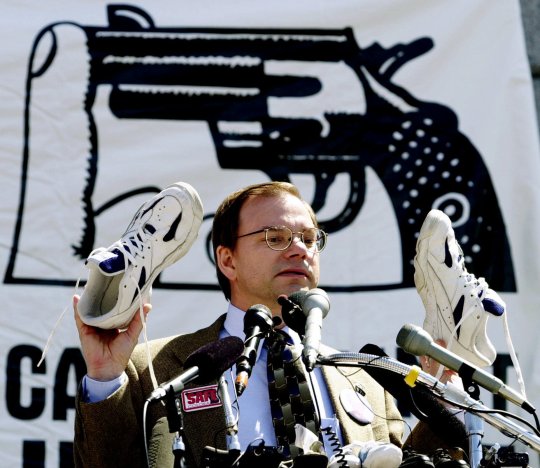
Tom Mauser holds up a pair of shoes belonging to his late son, Daniel, who was killed in the Columbine shooting, during a rally at the capitol in Denver, April 11, 2000. Mauser placed the shoes with over 4,000 other pairs, representing children killed by handguns in one year. (Photo: Ed Andrieski/AP)
The frustration, layered as it was upon recent grief, turned things ugly for a while in Newtown — another way that the community followed the same path as other places, but more so. Feelings, so close to the surface, were easily shattered. As New York magazine writer Lisa Miller wrote on the first anniversary: “There were 4,000 free tickets to a July Yankees game, an amazing boon, but 4,000 is less than a fifth of the town. NASCAR memorialized the Sandy Hook victims with a special car at the Daytona 500, and the fire chief who had stayed outside Sandy Hook Elementary that morning had the honor of unveiling it, not the police chief, who had entered the school.”
Just as stuff was becoming a surrogate for sympathy, so was money. More than $20 million was sent to Newtown from around the country, divided among 70 charities, the largest of which was the $11 million collected by the United Way. There were months of arguments between the families of those killed, the families of children who had witnessed horror and escaped, and the administrators of the United Way over whether the donations had been sent to help the victims directly or to help heal the town in general.
The fighting, in turn, spurred a backlash from those who felt the families should grieve more quietly, or more tastefully, or just move on already.
“With every shooting we’ve taken this process and we’ve fast-forwarded it,” Coni Sanders said. “We do it very quickly. Columbine stayed closed for months. The bodies weren’t removed for days. In Las Vegas it was business as usual the next night.
“I think a lot of that is by design,” she continued, speaking as a psychologist as well as a victim. “People not directly affected are overwhelmed by the number of tragedies, the number of deaths. I sometimes feel guilty because when Columbine happened there was such an outpouring. They canceled sporting events — well, except for the gun show, that went on. But stores closed. There was a special post office for all the mail we were getting. There was recognition that this wasn’t just an event, it was a change in how we existed.”

People attend an open house at the new Sandy Hook Elementary School in Newtown, Conn., in July 2016. Students attended the first day of classes there on Aug. 29, 2016. (Photo: Mark Lennihan/AP)
Now communities are left relatively unmoored to navigate the aftermath on their own. Those who have been there warn that at only five years in, Newtown still has a long way to go. Dave Cullen, whose seminal book, “Columbine,” came out 10 years after that shooting, and who still keeps in close contact with many survivors, noted that “those who were going to be OK were OK by 8 years or so. But lots are still not OK.”
Anniversaries, they warn, will continue to be hard. “That first year was just a constant trying to make it through, wondering how much more could you take,” Curtner said. The second year brought the realization that time did not heal quickly, and by now, with the 20th anniversary looming in March, she said, “it’s not so much today like it was the first five years or so,” but “it never goes away. It gets better, but it never goes away.
Memories, they say, will continue to be triggered by all the senses. For Thetford it’s unseasonable warmth, because the weather that day in March when she was shot felt like May. This past February the thermometer reached 70, and she left the school where she now works and drove over to Westside, just to be there.
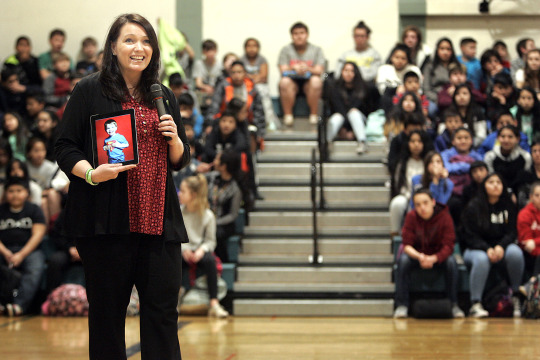
Nicole Hockley, founder and managing director of Sandy Hook Promise, shares a photograph of her son Dylan at a Harvest Magnet Middle School assembly in Napa, Calif., in March 2017. (Photo: Napa Valley Register via Zuma Wire)
For Coni Sanders it’s springtime noise. “One night I said to my husband ‘Oh, my God, what’s with those helicopters? Why are there so many around?’ And he said, ‘They’re always there; you just notice them in April.’”
The parents of Newtown say they are coming to understand all this — that five years is not long enough, that grieving is not binary or linear.
“There’s not going to be a point where we can put an ‘ed’ on the word ‘recover,’” said Michele Gay, mother of Josephine, who, with Alissa Parker, mother of Emilie, formed Safe and Sound: A Sandy Hook Initiative to promote safety in schools. “It’s always going to be an ‘ing,’” she said in an interview with Yahoo News. “We’re always going to be in process with this.”
Some of the most jarring reminders have been removed. The building where the shooting happened was completely torn down — after construction crews signed nondisclosure agreements that no photos of the interior or bits and pieces of the school ever be made public or sold. The $50 million, fresh-start of a structure that replaced it was opened to students in August of last year, filled with the latest in whimsy (indoor treehouses) and security features (bulletproof windows, doors that automatically lock from inside when closed).
But when you’ve lost a child, the parents have learned, everything becomes a reminder.
One night earlier this month, Mark Barden, whose son Daniel died at Newtown, was driving his daughter Natalie to her piano lesson when the Christmas lights along the route made him remember another ride to Natalie’s piano lesson, this one with Daniel along for the ride.
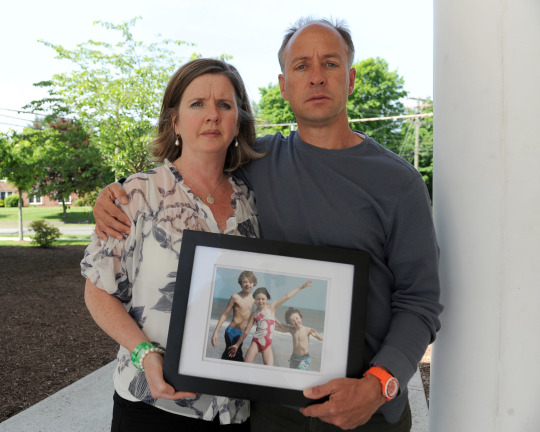
Jackie and Mark Barden, seen here in 2014, lost their son, Daniel, in the Sandy Hook shooting. (Photo: Enid Alvarez/NY Daily News via Getty Images)
“We played Christmas music in the car with Natalie and Daniel, and I noticed Daniel was crying as we listened to one of the songs because it touched him so deeply,” Mark said. With a jolt he realized that what he was remembered had happened five years ago to the day, on Dec. 6, 2012, a week before Daniel would die.
Some families have moved away, but most have stayed. Daniel’s parents considered leaving. “Jackie was ready to be away from everything and anything that reminded her of the tragedy,” Barden said – but then they asked their surviving preteens, James and Natalie, if they wanted to move. “They were both like, ‘Why would we want to go anywhere else?’ Everything we know and love is here.’”
Dylan Hockley’s parents discussed leaving town too, but chose to stay, in part, to be near others who shared their grief. “I don’t think you can run away from your problems,” Nicole Hockley says. “There’s always going to be Christmas lights, there’s always going to be 12/14, and I think here, there is a fantastic network of support and a community that has felt the varying degrees of tragedy, and there’s an understanding here that can’t be found elsewhere. This is where we choose to live.”
Many also choose to do as others did for them, to pay it forward as others join their tearful club.
After 26 were killed during a Sunday church service in Sutherland Springs, Texas, Hockley tweeted a note of condolence to the families of the victims on behalf of Sandy Hook Promise. “Twenty-six might seem like an arbitrary number, until it’s your community,” she wrote. “When your son is one of the 26, the number will take on new meaning. When your wife is one of the 26, the number will take on new meaning. These aren’t just numbers — they are people.”

Painted handprints with names of teachers and students are on a playground bench at the new Sandy Hook Elementary School in Newtown, Conn. (Photo: Mark Lennihan/AP)
And after two students were shot by an intruder posing as a student in Aztec, N.M., last week, Sandy Hook Promise reached out to those parents as well.
Near the end of that day, while police were still inside Aztec High School, Mayor Sally Burbridge released a statement: “There will be a Prayer and Candlelight Vigil this evening … in Minium Park. Please join us in beginning the healing process for our community.”

#school shootings#mass shootings#jonesboro#_author:Lisa Belkin#_revsp:Yahoo! News#_lmsid:a077000000CFoGyAAL#newtown#columbine#_draft:true#_uuid:96a93b7b-d9c2-33eb-80ba-bf69423e524b#paducah
0 notes